Polaris RPG (2016) by Asehujiko
introduction
Original SA post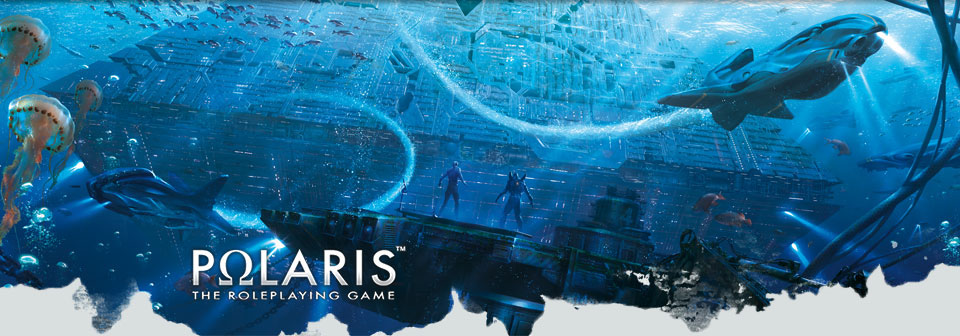
Polaris RPG(2016)
Part 1, introduction
Happy new year everybody and welcome to Polaris. This is actually the third edition of the game but the other two were French only and I know nothing about them. The game itself is set in an post-post-apocalyptic version of earth where everybody was forced underwater because of the melting icecaps and radiation on the surface some unknown number of years ago and two since lost precursor empires later, there now exist several underwater nation states where life has resumed mostly normally. PC's will most operate on the fringes of those societies, either socially as part of the criminal underworld or as mercenaries for a hostile country, or physically, travelling into the vast ocean filled with pirates, forgotten ruins full of lost technology and the occasional unspeakable horror, wizard dolphins or enemy battle fleets.
It is also blatantly unfinished and more than once, the rulebook only provides a cursory introduction on a topic before telling you to look in an upcoming splatbook for more information despite the core rulebook being over 500 pages thick already and commits many 90's sins such as having rules text hidden in fluff text, placing large chunks of the setting outside the player's reach, excessively simulationist rules, excessive rules in general, implying rules through formulae rather than writing them out, hinting at extra rules that aren't even there, an arduous character generation system that can leave you with an unplayable character by chance, plentiful trap options all around and a largely pointless second game on how submarines work that will leave half the table picking their noses due to role distribution in addition to all the above problems.
The core rulebook is split in two volumes, with the first part holding all the fluff, character creation and game rules and the second one being the armoury, vehicles and their rules, the bestiary, character creation and the game rules. No, that is not a typo, both character creation and the game rules are split between two separate books. Decisions like this will become a theme throughout this review.
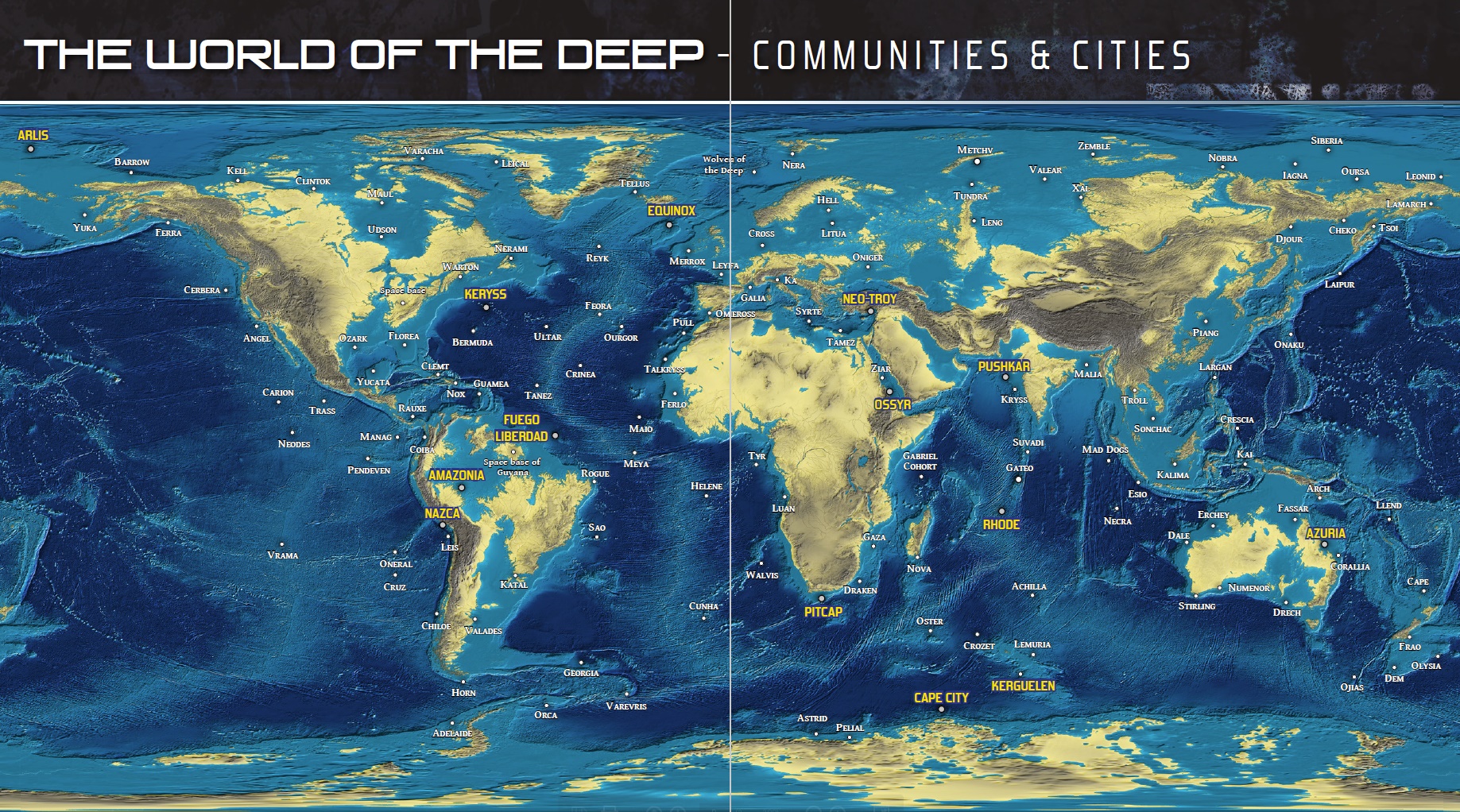
Both books open with this not all that helpful map of a handful of the game's population centres, without indicating which nation those cities belong to. Later on, there will be a map of the various factions... but with no cities shown so figuring out who a place belongs to requires both maps. Similarly it doesn't show any other potential places of interest.
The map is followed by a preface by main writer Phillipe Tessier, explaining the history of the game. Polaris was first created in 1996 and lists Dune, The Hunt for Red October and Battletech among others as it's inspirations. It was originally planned to take place above ground but the writers quickly decided an underwater setting would be more interesting. An undated second edition followed later but suffered from being too complicated(heh). The game almost died if not for some die hard fans but eventually a French publisher, Black Book Editions picked it up and a successful kickstarter was held, resulting in this book.
Next, Tessier talks about what he thought were the two biggest challenges with designing the game, namely including the breadth of underwater related technology that the players could come in contact with and properly simulating the effects of the pressure and darkness at the bottom of the ocean. Tessier found his own scientific knowledge to be insufficient for writing the game how he wanted it to be so he brought a physicist on board(well here's a grog game red flag if I ever saw one). Tessier talks about how while "some" might be annoyed by the technical aspects and find it to be getting in their way of enjoying the game, he considers it to be an essential to making the setting coherent. Next, he brought in a third writer to streamline the game mechanics of the 1st and 2nd editions, which makes me curious as to how horrific those must have been because this game is everything but streamlined. He also brings up the advances in technology that happened in the real world since 1996, all of which is included in the book too because realism.
The final few paragraphs of the preface talks about upcoming splatbooks and novels, including a offhand mention of a country that isn't even in the book. This won't be the last time this happens and it won't be limited to just the fluff either.
Next up, opening fiction!
The story starts in medias res, with mercenary pilot Eryan, an expy of a player party, sinking to the ocean floor inside a suit of power armour, thinking back on him getting contracted by the Mediterranean League to test out a new fighter supercavitating fighter craft, capable of operating both underwater and in the air. Shortly after the start of the test flight, a large submarine surfaces nearby which folds out it's pressure hull, turning into a hydrofoil battleship, which sinks the League's carrier and observation ships and shoots down Eryan's plane. He survives due to his power armour but it is too damaged to deploy a distress beacon or equalize it's buoyancy so he sinks to the bottom. While this happens, he spends an entire page lamenting that the suit of power armour he was issued with by the the stingy fucks of the Mediterranean League has a maximum operating depth of 4000 meters and how he'll surely be crushed by the water pressure. Luckily for him, 95% of the Mediterranean Sea is less than 4000 meters deep and he lands safely on the seabed. Once he is on the bottom, he wanders around for a bit until his suit runs out of oxygen but just before he passes out he encounters an underwater structure with a large eye symbol on it. A door opens, light shines out and Eryan slips into unconsciousness. As he wakes up, the structure is gone and he is about to be eaten by a giant eel but is saved by an even larger underwater spider and passes out again.
Next, the sailors Eryan is drinking with call bullshit on the story of his survival, finish their drinks and walk off. This turns out to be a reoccurring problem for Eryan, who finds himself alienated by pretty much everybody since his near death experience, caused by a mysterious entity following him around, quietly persuading everybody around him to not engage with him. On the upside, his manipulative stalker also keeps him out of harms way, soundlessly killing two muggers sneaking up on him while his back is turned. Unaware of this going on behind him, Eryan continues to wander the streets of Equinox, the setting's largest city until he encounters a mysterious hooded figure, who tells him to go home, a command which he immediately obeys without really knowing why. The hooded man is a Silent One, not quite human servant of the Geneticians, the oldest and greatest of the lost empires, and has the ability to not be noticed if he doesn't want to. The Silent One is charged with safeguarding those marked by the Eye, unwitting subjects in a mysterious experiment run by the true masters of the ocean. Metaplot!
This is the last time that this experiment, the silent ones or their masters are mentioned in the core rules. Splatbooks!
Next up: Book 1, Chapter 1: The World of the Deep
Book 1, Chapter 1: The World of the Deep
Original SA post
Polaris RPG(2016)
Part 2, Book 1, Chapter 1: The World of the Deep
This chapter is subdivided in four parts:
-History, starting with the aftermath of the apocalypse
-Information on all the nations and cities in the game. At 50 pages, this sub chapter is longer than the other three put together.
-An alphabetic list of world building titbits
-The surface, the underground and outer space. Mainly serves as repository of hooks for splatbooks
Chapter 1.1: History
This chapter opens up with a small setting overview, going into a little bit more detail on what kind of environment the players can expect: Humanity suffered a huge setback, both from the apocalypse itself an radiation induced sterility that now affects 80% of the population and has been reduced to several small underwater states in constant conflict. Outside the main stations being fought over, pirates and raiders rule supreme. Players can be soldiers of one of these nations, mercenaries with a more loose allegiance or just plain adventurers doing stuff like solving mysteries, raiding forgotten ruins, founding settlements and getting into fights with pirates over territory and salvage. The hard life under the waves breeds hard men doing what they must in order to survive and paragons of morality will be few and far between, in conflicts between third parties, the players will rarely find themselves with a clear black or white choice but they must put their difference aside and unite against a common adversity if humanity is to survive. Dead end metaplot reference count: 2. Their equipment will likewise follow a similar theme of being a shadow of it's old self, consisting mostly of rust and duct tape with new, or better yet, recovered precursor technology, being a rare and precious thing. Not all hope is lost however and through battling against the odds they may yet topple an oppressive empire or rout a fleet of sadistic raiders, to the betterment of all humanity. Even further, the players may be the heroes to create a new order and start the next golden age.
The final line is one I'll copy paste from the book:
quote:
All these elements and many others make up the backdrop
of this universe in which one great mystery prevails: the
Polaris Flux (also called Flux or Polaris Effect).
I hate this text block. None of what it says about being humanity's new leader is supported anywhere in the rules. You start the game as a murderhobo you'll end the game as a better murderhobo. Even worse, all of this is only secondary the -~'* great mystery *'~- of wizard spells(and it's synonyms in parenthesis). The book will never explain how or what it is but it was important enough to name the whole game after it and everything you, the players, do is irrelevant compared to it and fuck that. Also, dead end metaplot reference count: 3
Next up, some more fiction. We get two short quotes and a long one, one from Vulrick the Mad(a playtester, going by the dedications section) about humanity being born from the oceans and now coming back to them to die, which is not quite how evolution went but okay, we'll take it. After that is the long one, by a historian: Nobody knows how the cataclysm happened or what is was, but some speculate that either the Hegemony, the oldest and largest underwater nation, or the Cult of the Trident, the wizard-run United Nations, have records dating back to that time. Either way, the result is that the surface is now covered in everlasting lightning storms, tornadoes and radiation, animals are now monstrous parasite carriers, trees are now predatory and will ensnare pay with their branches and smaller plants have learned to move and hunt. Humanity fled beneath the waves and this is where we are now with the warring states and pirates.
The next quote is another one of those that needs to be seen in full:
quote:
“What do those half-witted primates know about
History? Look at them, struggling in our web like
trapped insects. They do not know that we imagined
their History, we created their History, we are their
History!“
— Cyrull the Creator

...oh. I can't tell if this is a meta joke about Tessier being the one who made the setting or if he seriously declared his self insert to be the closest thing the game has to a deity. Either way, Cyrull's "Web" will never be mentioned again. Dead end metaplot reference count: 4
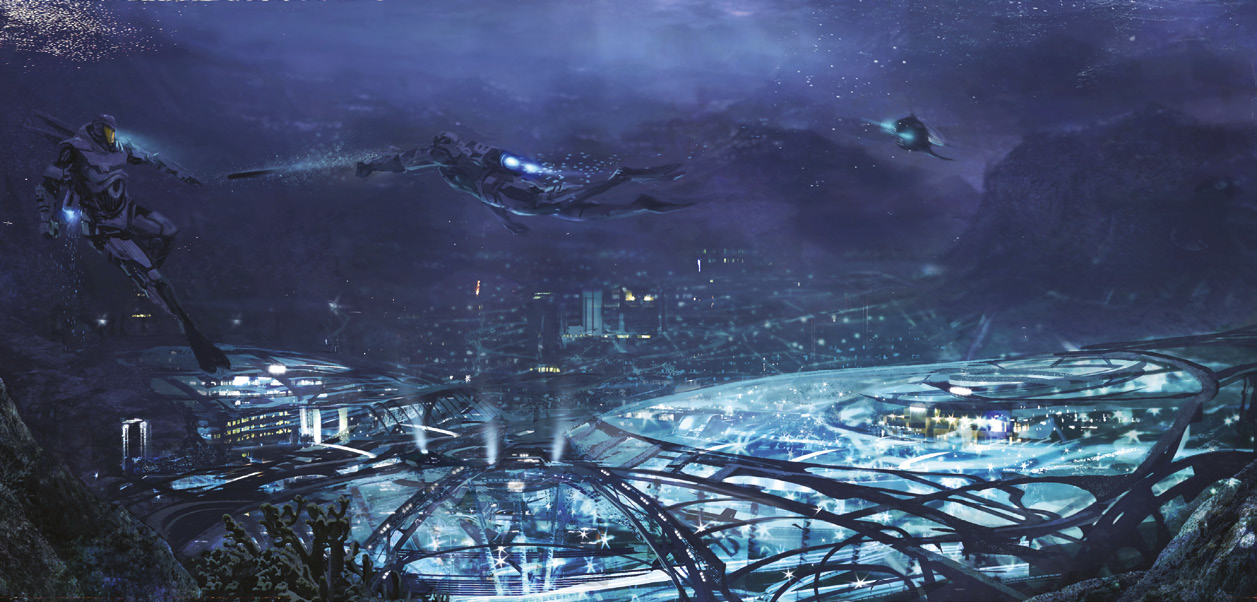
Although a few pieces are repeated, the art in the book is pretty nice for the budget it was made on, at least if you like the colour blue.
Let's move on to the actual meat of this section, history
The Beginning (? to 0)
After the cataclysm, humanity was about to die out due to inability to keep their population numbers up while hiding under the sea. The Geneticians came with their secrets of the Fluid, a means of breathing underwater and many others inventions including exo-respirators, oxygen filtering backpacks for dolphins and whales. This is important because as we'll later discover, those marine mammals are wizards now. No explanation is ever given for that but they will have spells once we get to the bestiary. With the Geneticians in charge humanity conquered most of the ocean and built great cities everywhere with their high technology. Outposts were established underground, in select places of the surface, and on the moon and Mars. Then something went wrong and a civil war erupted, destroying most of humanity, again. The rebel faction emerged victorious, declared the Geneticians to be a great evil and created the Azure Alliance.
The Golden Age (0 to 150)
Humanity is down to less than a billion people for the second time and the Geneticians remotely wiped all computers around the world on their way out, leaving the world without the means to produce new Fluid, Hybrids or hyperalloys, the latter two being merman mutants and shape-shifting nanite metal. The Alliance spends most of this time reverse engineering these technologies while humanity rebuilds it's shattered cities once again, rediscovering most of them and making it as far as the moon before the third apocalypse happens. Yes, again.
The End of a Dream(150 to 250)
In the year 150, the Burrowers, an species of not-orcs, attack from underground, swiftly destroying many cities built into the seabed and oceanic ridges. What's worse, the surviving humans in floating installations not connected to the earth are rapidly turning sterile. A great breeding project is undertaken to create as many scientists as possible to reverse it but the social unrest caused by this fractures the Azure Alliance into warring micro states with piracy and banditry reaching an all time high. In 250, the Alliance is formally dissolved.
The New Order(251 to 400)
I am irrationally annoyed by the inconsistency of the first year of this era not being the last year of the previous on like with the others. Anyway, the world continues to be shit for a century or so until 361 when the Hatteras community, one of the splinter groups from the Azure Alliance discovers a forgotten cache of Genetician weapons, including a ship made out of hyperalloy and the means to produce Techno-Hybrids. Everybody declares war on them for this but are unable to defeat their technologically advanced opponents. Nine years later in 370, Hatteras has conquered most of it's enemies and proclaims a new state, the Hegemony. The Hegemony restarted the Azure Alliance's controlled breeding program and began colonizing the ocean for a third time, which brought them all in conflict with yet more underwater nations, most of which were swiftly crushed except for the Red League, which had been the Hatteras' greatest enemy since they first discovered the Genetician depot. In 375, Admiral Piotr Devrac from the Coral Republic attempted to broker a peace between the Hegemony and the grand coalition of everybody they pissed off with their expansionism, led by the Red League. He suggest a meeting in Equinox, the city where the peace loving Cult of the Trident resides. He gets ridiculed out of court by both sides. Next, the Cult of the Trident themselves declared that they'd destroy any kingdom refusing to cooperate. After sharing a hearthy laugh, the Hegemony and the Red League declare a truce and send their fleets towards the upstart third party.
The city is hidden in what the game calls a "heat flow", tube shaped irregular streams of water impenetrable to sonar and causing strange electromagnetic interference. Equinox is located at the point where all these streams intersect. After entering it's invisibility field, the armada find the city surrounded by dolphins and whales. Before they have a chance to report this peculiarity, the wizards in the Cult completely annihilate the entire fleet with their Polaris powers. Now without a navy, the Hegemony and the Red League are forced to accept Devrac's plan for a meeting, which would later be called the Admiral's Council. At the Council, the Cult sets forth some ground rules for all states to follow:
-Any scientific breakthrough in the field of genetics must be sent to the Genetic High Council, a neutral scientific organisation in Equinox with representatives of all other states
-The Hegemony must share their hyperalloy technology with the other states
-No fighting near underwater farms
-Equinox must always remain neutral
-All states must colonize as much of the ocean as they can
-All states must contribute to a space program and all space stations are neutral territory
-Underwater pollution is forbidden
-Marine mammals must be protected
-The Cult of the Trident gets permanent free passage in every city and outpost
-Anybody with the gift of wizardry must be handed over to the Cult
-Each state pays a monthly tax in fertile individuals to the Cult
-In return, the Cult will provide everybody else with Fluid and Geno-Hybrids
-All this is enforced by the Fellowship of the Watchers, an organisation paid for by the Council's member states and it's staff selected by the Cult
The next 25 years or so, Equinox diplomats prevent wars from going apocalyptic again and the world settles into a new status quo, one dominated by plotting and scheming instead of all out war, under the somewhat hands-off leadership of the wizard UN. With the ban on the wholesale slaughter of troublemakers, many large states find it hard to keep their territory under control and several minor nations declare independence. Side note: The map later in the book with territorial zones of control shows no two states sharing a border.The book also makes a note here that the moon gets recolonized again in 498, nearly a hundred years after this era is supposed to end. Players can't go to space anyway.
Modern Times(400 to 565)
This is the era that you'll be playing in. Equinox prevents border skirmishes from escalating into somebody getting nuked and most conflict between major powers is resolved with cloak and dagger. The dangers in the depth are more immediate though with many pirates and raiders abound, deadly creatures lurking everywhere and the massive Burrower armies standing at the ready to attack anybody foolish enough to wander underground. In a more organised fashion there are the Black Sun Fellowship, a totalitarian splinter group of the Cult of the Trident(they're literal underwater nazi wizards), The Fellowship of the Deep, a terror organisation who wish to eradicate all of humanity as part of it's apocalyptic prophecies(yes, they put fucking daesh in the game) and the Leviathan Community, a secretive society that lives in a remote trench together with their whale wizard friends that will attack all outsiders.
Recent Events(566 to 569)
Here we go again with the inconsistent dating scheme! This section mainly talks about the Hegemony militarising again in incredibly vague "some whisper that the Patriarchs may be preparing a new super weapon" form. Because the upcoming nation write-ups, starting with the Hegemony, are basically the same text with far less outsider perspective waffling, I'll be skipping most of it. The most important parts are the re-appearance of Azure Alliance ships, crewed by parties unknown(dead end metaplot reference count: 5) and the unexplainable wholesale destruction of a Hegemony community(6), Contact with a new non-human species living in the deep called the Ternasets, a new Plague affecting the Coral Republic, dead bodies found inexplicably aged at high speeds found in commercial harbours, two new nations declaring independence, Amaziona and Rhodia, rumours about a hidden breakthrough dealing with the sterility crisis, a megacorp called Cortex doing megacorp things and the name "Conscience" spooking all major powers(7)
Next up: Chapter 1.2: Civilizations of the Deep
Book 1, Chapter 1: The World of the Deep, section 1.2: Civilizations of the Deep
Original SA post
Polaris RPG(2016)
Part 3, Book 1, Chapter 1: The World of the Deep, section 1.2: Civilizations of the Deep
Opening fiction for this sub chapter is a pretty inconsequential two line bit about a Coral Republic citizen talking about how cool and beautiful their country is. After the opening quote we're told that the majority of settlements are not technologically advanced enough to maintain their own technology and must barter with larger and better equipped stations. Independence for these disadvantaged stations is guaranteed by the Sub-Marine States Organisation, a neutral committee located in, you guessed it, Equinox. To qualify, settlements have a few requirements that they must meet, which the book helpfully lists out:
1. The settlement has to produce something of value, mining or agricultural towns thus being the most common but exporting mercenaries is also ok. The SMSO is the final arbiter on what counts as "valuable"
2. The settlement must have a larger sponsor. The sponsor is obligated to protect the new settlement and supply the initial resources with which it is established and in return they get to seize the new settlement's entire wealth if the colony ends as a failure.
3. The settlement must consist of at least 100 individuals, which must include at least 10 fertile couples. These may be settlers from the sponsor state(as opposed to homeless divers just swimming up to Equinox...?)
4. The settlement must keep up a birth rate of 5 babies/year.
You might notice that the math for this doesn't quite work out especially if you consider that most of those children will also be infertile themselves.
5. Anybody with talent for the Polaris Effect must be handed over to the Cult of the Trident
6. The settlement has to send over a fertile couple to the Cult of the Trident for genetic research every month once they've reached 20% fertile population.
Because each settlement starts out with a 20% fertility rate, does that mean the Cult expects them to hand over 1/10th of their reproducing population on day 1? Polaris is a game that's not very good at math, something we'll be seeing quite often once we get to the actual rules
7. The settlement must hand over any discovery related to genetics to the Genetic High Council in Equinox.
8. The settlement will be considered independent of it's sponsor after a year and be a nation of it's own after 10 years or if a cache of Genetician tech is discovered.
9. The settlement can't have an army or send envoys to the SMSO or GHC until it's gained independence.
10. The settlement needs to contribute to the SMSO's space program somehow.
Spoiler: No country ever bothers with this crap and just makes their own colonies on their own time.
Now before I start the actual nation write-ups, here's the map with the actual borders on it from the last two pages of the book:
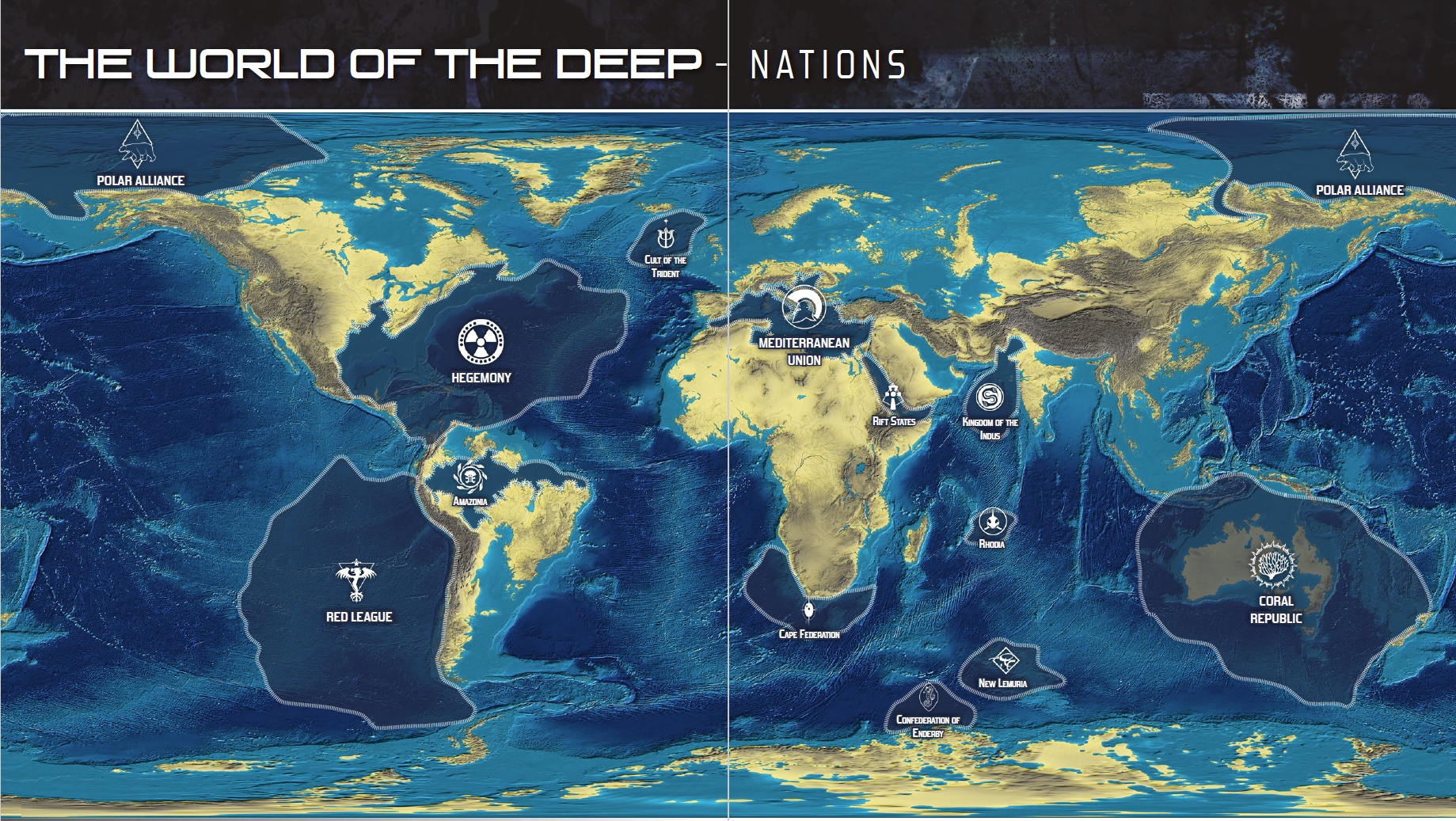
Five major states(+Equinox), seven minor ones and a fuckton of independent settlements(see the other map). Major factions get detailed overviews of their history, society, territory and persons of interest, followed by a description of all their towns and stations while minor ones only get a short blurb and the settlement list. After that there are the landless factions like the Fellowship of the Watchers and the unaffiliated cities. All settlements get this stat block and description, of varying length and relevance, like this:
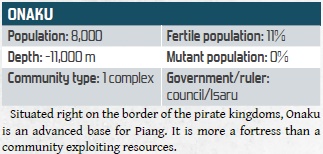
And I do mean ALL of them. There are 141 settlements in the book, +1 for the one featured in the example adventure in book 2, which is not in here.
Anyway, let's start with the first major nation,
Hegemony
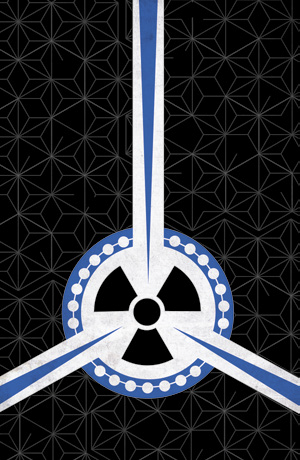
For some reason horizontal flags fell out of favour after one of the many apocalypses.
The Hegemony directly controls most of the north-western part of the Atlantic but like any good militaristic expansionist state, their fleets range across the globe. They possess great mineral and agricultural wealth and are rich enough to line their entire border with sea forts.
History:
The history of the Hegemony starts with Karl Paramar of the large and wealthy Hatteras station, then part of the Azure Alliance, leading the Azurean fleet against the Geneticians. When the Alliance fell apart, Karl's grandson Yvan proclaimed himself admiral. The Paramar family had a problem though and that was sterility, causing a bloody succession crisis in Hatteras when they finally died out. The military faction won and for the next 20 years, admiral Trenton greatly expanded the Hegemony's armies, before committing suicide in 301 as a result of carrying a dark secret with him. His successor, admiral Keryss, decided to start a big war against basically everybody around them, leading to the formation of the Red League to oppose them out of various ex-Azurean microstates, which lasted until a ceasefire was signed in in 339. Keryss died a few years later in 346, with his son Olmon becoming the new admiral. Olmon was a mutant and generally considered a simpleton but he proved to be surprisingly good at statesmanship, which may be attributed to a hidden force behind the throne pulling his strings. Under his rule, Hatteras started to focus on farming, fertile families were given preferential treatment while mutants were forced into menial jobs and the armed forced. Based on scraps of pre-apocalypse history, Olmon reintroduced titles of nobility and reformed the societal elites into a true aristocracy. A new capital, named Keryss in honour of Olmon's father, was build as a giant domed city, in which pre-apocalypse surface conditions were recreated. Olmon also crowned himself Emperor in 357, but that resulted in him getting assassinated on his second day on the job.
The next year, the navy and the council seized power in the leaderless nation and installed the Patriarchs as government. The twelve Patriarchs never leave their palace and only communicate to their underlings in the form of holograms, always wearing face concealing masks when they do so. The reinstate the office of the High Admiral, now their representative on day to day matters. In 361, Hatteras scientists found a Genetician depot and after several months of brutal warfare against it's automated combat drone defences later, the Hatteras fleet finally gained access to it's content. The Red League didn't like their arch enemy getting all the cool toys and declared war against the depleted nation together with it's numerous allies from the Pirate Kingdoms. After a year of initial success for the Red League, the Hatteras scientists managed to bring the Genetician ships from the depot online and crushed the invading fleet. The depot also contained the tools to create Techo-Hybrids, merman cyborgs infantry that can breathe underwater. By 370 the counter-attack had passed the pre-war borders and the Red League was forced to accept an unfavourable peace treaty. Hatteras and the territory it had acquired in the war would henceforth be known as the Hegemony. Five more years of conquest followed until the destruction of both the Hegemony's and the Red League's fleets at Equinox. After the Admiral's Council, in which the Hegemony was forced to return several captured cities, the Patriarchs changed tactics from open warfare to intrigue for the next 150 years.
In 548, the current High Admiral, Viramis, came to power and ordered a great shipbuilding project, creating two battle cruisers that are currently the largest ships in the world. With these, the Hegemony attacked the state of Fuego Liberdad, hoping to acquire a genetician superweapon from an ancient vault as part of something the Patriarchs call the Exeter Directive, a scheme that would wipe out the Red League, Coral Republic and Cult of the Trident. Although the battle outside was a disaster, the Hegemony managed to escape with the weapon. After the war, Viramis discovered that the weapon would not only destroy the Hegemony's enemies, but also the Hegemony itself and all life on Earth and ordered the cancellation of the Exeter Directive. Large sections of the Prism, the Hegemony's secret service, openly disobeyed the order and continued working on the weapon. Around this time, the Hegemony's underground settlements encounter the Burrowers again and the Hegemony is swiftly pushed out of the underground. Viramis then starts a purge of disloyal elements of his own forces, while the Patriachs begin openly ordering troops loyal to themselves around into a new wave of expansionism, circumventing the High Admiral completely. Currently, the Hegemony is embroiled in a secret civil war between the Patriarchs and the High Admiral.
Next up: Chapter 1.2: Civilizations of the Deep, more Hegemony stuff
Book 1, Chapter 1: The World of the Deep, section 1.2: Civilizations of the Deep
Original SA post
Polaris RPG(2016)
Part 4, Book 1, Chapter 1: The World of the Deep, section 1.2: Civilizations of the Deep
Still with the Hegemony, they have the longest single lore text of any faction. Onto their society:
The Hegemony has a population of about 48 million people, the second largest after the Coral Republic and is tied for having the best technology with the other major nations. Their dominant religion is a cult of personality based around the Patriachs. They officially(here we go again with the limited perspective nonsense!) recruit from the most intelligent candidates created by the breeding centres and the general population believes them to have the Hegemony's best interests at heart. Below them is the High Admiral, the Patriarch's executor and in practice, the sole ruler of the Hegemony. The current High Admiral is Lord Viramis, an expansionist who views an orderly and obedient society as the highest good. He is also quite capable in personal combat with his custom made pure white suit of power armour. Most of Viramis' power is derived from the Prism, the Hegemony's intelligence service. Aside from a few recent events with regards to the Exeter Directive, the Prism usually follows orders from the High Admiral. The Prism is heavily subdivided with each department focussing on one specific task, such as include tracking down any form of dissidence, keeping watch over the fleet admirals, capturing fertile citizen who refuse to go to the breeding centres and providing "political counselling" to Hegemony dignitaries. Public safety is handled by the Security & Surveillance Action Forces, the Hegemony's powerful and numerous police force which also possesses many specialized intervention units. Aside from the intelligence service, Viramis also has his own personal army, the Pandora Cohort. The Pandora Cohort contains Techno-Hybrids, underwater commandos, saboteurs and spies and several highly trained and motivated infantry units, most of which are given combat drugs that inhibit emotions. Any regular Hegemony division will have some form of Pandoran unit attached to it when it is deployed.
This chapter has character art for a handful of important leaders per nation but the majority are Serious Looking Dude in Uniform so I'll only post each faction leader or otherwise notable ones.
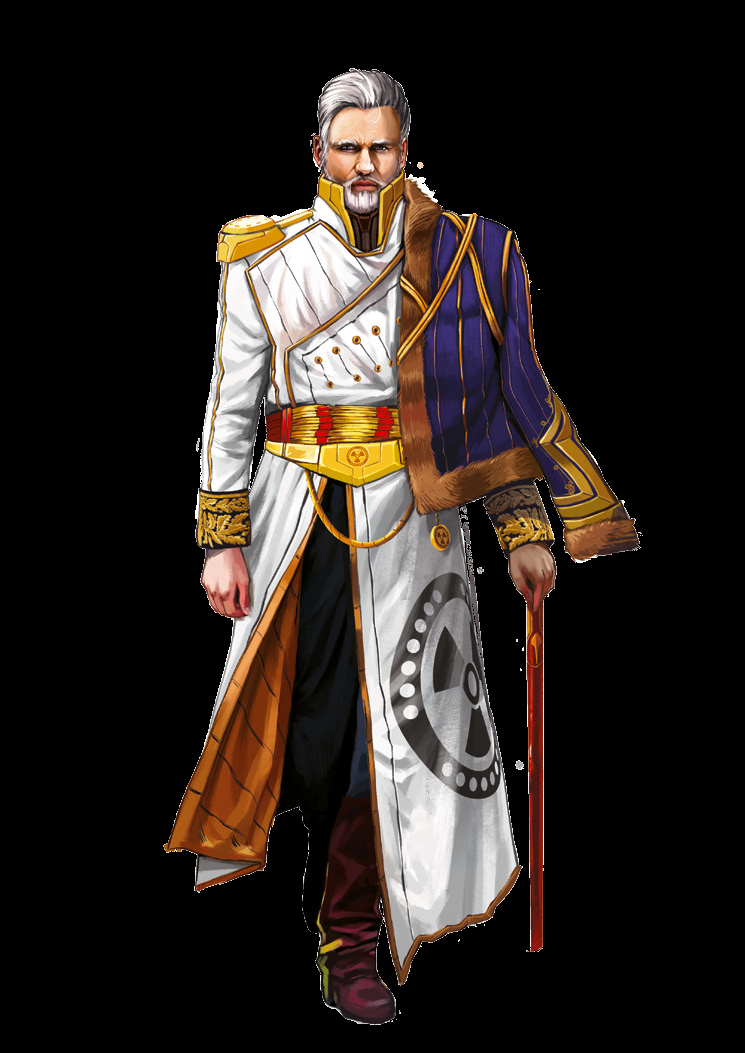
High Admiral Viramis
Hegemonian society is heavily stratified with military officers at the top, followed by scientists and fertile males, who, despite their high status, have little freedom of movement. Next come the clergy and the aristocracy, which makes up the majority of the Hegemony's elite. The middle class consists of the Hegemony's many security forces, lower ranking armed forces members and labourers. For them, the quality of life in the Hegemony is relatively high due to it's technological base, provided they do not not attract negative attention from the government. The lower class consists of anybody who is deemed not useful to the Hegemony; criminals, intellectuals, the old and infirm, the sick or crippled. The Hegemony also practices slavery, with most slaves being prisoners of war or opponents of the Patriarchs and the High Admiral. Hegemonian society does not think ill of mutants, as long as their productivity is not impacted by their mutations. The lower classes are closely observed and those with no useful function are often conscripted into the armed forces or used as test subjects for medical experiments.
Fertile children are heavily guarded and are locked up in education centres until they reach maturity at around 18 to 20 years of age. After that age, most men are released and generally enjoy high social statues but are not allow to move too far from the fertility centres and must make mandatory deposits to the Hegemony's sperm banks. The most valuable individuals, either for research or productivity however are treated the same way as women and must remain in the fertility centres. Fertile women are imprisoned until age 40 and is used to produce children for the Hegemony. Hegemonian scientists have developed a way to induce the formation of monozygote siblings and most births are of an entire "litter" of identical children, most of which will be infertile and put up for adoption. The ones that are fertile will be brought to the education centres where the cycle will begin anew. Women who make it to the age of 40 are given a state pension and their own house, one of the few ways in the Hegemony to acquire one without being part of the nobility and inheriting it.
Despite the high efficiency of the Hegemony's reproduction program, the total birth rate is only barely above the death rate as the inhumane nature of the system causes many to flee and go into hiding and public opposition to the centres is so widely spread throughout society that the Prism and SSAF have been unable to root it out despite spending the majority of their resources on it. The Patriarchs seem to be partially sympathetic to their cause and one of the largest breeding centre opposition groups, the Pact of Hera, has been granted semi-legal status by them, much to the chagrin of the High Admiral.
Technology wise, the Hegemony leads in military sciences, specifically drones, molecular armour, weapons, Techno-Hybrids and warships. On the civic side they focus mainly on large prestige projects like the domed capital of Keryss and are a major contributor to the Cult of the Trident's space program.
Territory
The Hegemony runs high intensity resource extraction operations all over their turf, mining the majority of the world's Cylast, used to make hyperalloys and tri-terranium. Their food supply comes from coastal shallows where the soil is fertile and water pressure low but working here is a high risk operation due to atmospheric disturbances from the surface reaching down to the seabed and most of their electricity is obtained from geothermal power stations in the Mid-Atlantic ridge. The Hegemony is said to encompass twenty major cities and over a hundred smaller stations, although nowhere near that number are detailed in the book, most of which are located in their core region between Bermuda and the New England Seamount chain with their capital Keryss located at the Kelvin Seamount.
Keryss is formed by a giant one kilometer high dome made out of SapphireT, a material created by the Geneticians, which can be covered by a layer of molecular steel plates is case of an emergency and is constantly patrolled by maintenance drones looking for any cracks or other weaknesses. Although domes are a common design, what makes Keryss unique is that the entire city beneath the dome is based on the ruins of the pre-apocalypse surface civilizations found by the Hegemony's cross-surface military expeditions. The Hegemony projects an image of blue skies and starry nights on the inner surface of the dome and maintains small parks and forests inside with powerful ventilation systems providing a slight breeze to strengthen the image of a surface city. Keryss is a rich city with many amenities and is mainly populated by nobility and the upper middle class with it's slums located outside the dome in nearby sub-stations. Keryss also acts as a human shield for many of the Hegemony's military installations hidden below the domed city, which is repeated in it's metropolitan area where smaller townships are each built on top of a station of military or strategic value. Connecting Keryss with the rest of the Hegemony are large tunnels containing roads and high speed rails, with an offshoot into neutral territory providing a direct connection to Equinox. These tunnels are full of automatically closing airlocks in case of a breach and are constantly patrolled by the SSAF.
Outside the capital the Hegemony uses more traditional designs for their cities, scaled up pressure hulls or cities sunken mostly into the seabed. The hegemony also possesses the second largest commercial shipping sector and has a tendency to prefer bulk shipping with convoys of gigantic cargo vessel and military escorts. Speaking of which:
Armed Forces
Most of the Hegemony's military strength is concentrated into two gigantic cruisers*, the Atlantis and the Artemis. With their length of 3000 meters, width of 223 meters and height of 200 meters, these are the largest ship in the world, requiring a crew of 17.000 each. Aside from them, the Hegemony has many smaller cruisers and escorts, as well as a sizeable interceptor fleet but somewhat unusually, no other battleships. They also possess many Techno-Hybrids, seabed bound tanks and automated drones, with the latter defending the Hegemony's territory from numerous autonomous defence stations. The best trained of the Hegemony's foot soldiers are deployed in surface exploration or underground anti-Burrower units. The Hegemony's enormous military budget means most troops have high quality and well maintained gear and their armed forces are numerous enough to not require much in the way of mercenaries.
*these were referred to as battle cruisers in the history section and given how other factions possess battleships that are explicitly smaller than the Atlantis-class, probably a better classification for them. To it's credit, the book doesn't use the term "dreadnought" for ships that are very obviously not dreadnoughts.
Next up: Chapter 1.2: Civilizations of the Deep, Hegemony personalities and locations
Book 1, Chapter 1: The World of the Deep, section 1.2: Civilizations of the Deep
Original SA post
Polaris RPG(2016)
Part 5, Book 1, Chapter 1: The World of the Deep, section 1.2: Civilizations of the Deep
Almost done with the Hegemony, only their list of personalities and locations to go, starting with the personalities:
-The council of Patriarchs
A mysterious group that lives on top of the Kelvin Seamount, overlooking the Hegemony capital of Keryss. Nobody knows what they look like due to them permanently wearing masks and only communicating by hologram. Hinted at elsewhere in the book to be not quite human if you read between the lines. Who or what they are is probably in the Hegemony setting book for the first edition of Polaris RPG, which was released in 1996, only in France, only in French and never translated. If anybody is willing to track that one down, be my guest. The Patriarchs are considered divine avatars in the Hegemony's unnamed plurality religion.
-Grand Admiral Valastor
Newest Grand Admiral of the fleet and commander of the Artemis, the second Atlantis-class battle cruiser. Brilliant strategist, has seemingly no emotions and is a Patriach loyalist.
-High Admiral Viramis
Commander in chief of the Hegemony's armed forces and the Patriach's representative for day to day matters of ruling the Hegemony. May be either 69 years old or over a century and running on organs harvested from lower class citizen depending on who you ask. There's a big description of how he looks here which is somewhat superfluous because there's a picture of him on the previous page. He is always surrounded by several his own loyalists and probably a Patriarch spy or two. Also he is somehow a past war hero now despite the Hegemony being at peace for two centuries before his ascension?
-Admiral Alkard
Despite seemingly being lower in rank than Valastor, this 56 year old dude is a a great leader and in charge of the entire fleet. Never leaves Viramis' side, where he serves as personal advisor.
-Admiral Vira Our
Was the previous Grand Admiral commanding the Atlantis for 14 years, demoted after the ship ran aground during the Fuego Liberdad invasion. So apparently Grand Admiral is the rank for whoever commands one of the Hegemony's superships and the ranks both above and below it are called Admiral? That isn't confusing at all. 50 years of age and known as a (relative) moderate among the regime. It is rumoured that she is fertile but avoided being imprisoned in the breeding centers because of a connection to the High Admiral.
-Admiral Veer
Commander of the Hegemony's border troops and exploration units. Highly efficient and completely emotionless.
-Baroness Vilma Terrastet
Close friend to the High Admiral and owner of the largest passenger line in the world; Nova. This makes her the richest woman in the Hegemony. She is cunning, possessive, power hungry and barely looks 30 while actually being 45 years old. I think the book is trying to imply she also harvests poor people for organs but 30-45 is totally doable with regular make-up.
-Prince Vaughn Ebreaer
The head of the most powerful aristocratic family in the Hegemony. A reformist and opponent of the High Admiral, one of the very few people allowed to do so openly.
-Telma Tiltane
A rebel against the Hegemony's oppressive reproduction policies, she herself being an escapee from the breeding centers. A lot more popular among the general populace than anybody would admit when the Prism is around and the stream of new sympathizers joining her rebellion grows every day. She is also aware of the rift between the High Admiral and the Patriarchs and considers Viramis and his breeding centers to be illegitimate. Disappeared after a recent commando raid against one of her secret bases, nobody knows if she is captured, dead or in hiding.
So yes, just as we have three apocalypses for some reason, the internal conflict in the Hegemony also has a third faction that is hidden away three quarters into a list of which Serious Dude in Uniform commands what ship. With the Patriarchs requiring the GM to basically make up their entire backstory for them to use them in a game, I guess a faction who's main motivation is "let's not have the country be so fascist and mistreating it's own citizen please, tia" is an improvement because it's the first plot hook this the game that the players can actually do something with. To celebrate that, here's the official art for somebody who may or may not even be alive by the time the game takes place.
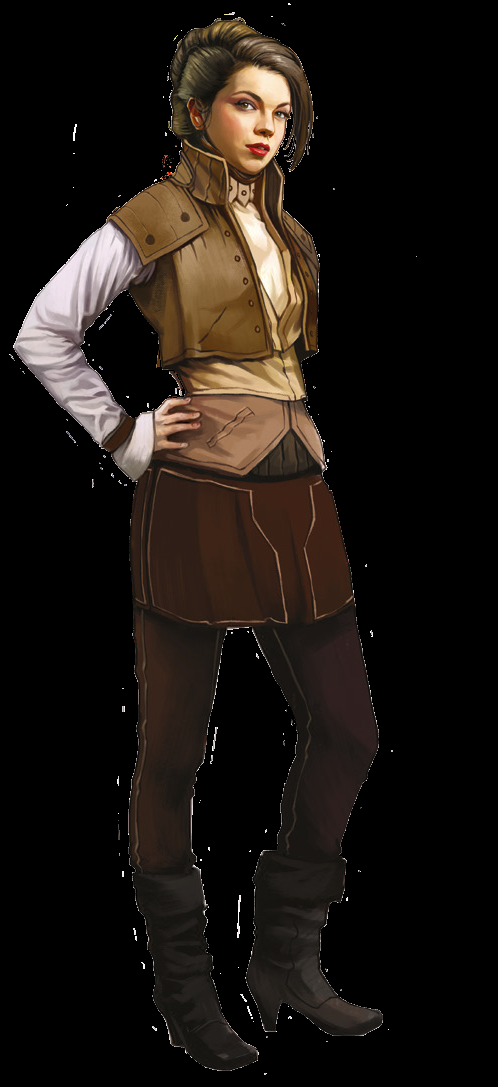
-Marquis Ovar Godter
The Hegemony's ambassador in Equinox. The book definitely said something about the Hegemony ambassador there getting murdered recently but this guy is written as if alive so maybe they have multiple of those as well? He is 58 years old and a famous pacifist but will a close friend to the High Admiral despite their opposed world views.
Hegemony Communities
Remember how the book said there were 20 major cities in the Hegemony two pages ago? Well now there's 15. The book still acts as if this is a conclusive list though so I guess the mysterious metaplot nonsense ate another 5 of them since it's last mention. The book gives them all that little stat block I showed a few updates back which I'll be truncating a bit because the bottom line on it never ever says anything useful about the station in question. The book also insists on giving you the exact depth for every station so you know if the various kinds of equipment that can be on your diving suit are capable of resisting the pressure at that depth. Yeah it's that kind of game.
Bermuda
Population: 1.000.000
Depth: -3.200 to -4.200 m
Fertile population: 60%
Mutant population: 1%
Bermuda is a tourist city where mutants are not allowed and will be arrested and deported if found. You might recall the Hegemony being generally ok with mutants last update. Well, not any more. Found here are many companies dealing in luxury goods and services, including Nova. This is also where the breeding centres are and there are guided tours showing the playgrounds with children happily playing, demonstrating that the Hegemony's reproduction policies are quite humane, contrary to the malicious rumours spread by Telma Tiltane's terrorist organisation. This fools absolutely no one. The Hegemony's tunnel network connects the city to Keryss, Clemt, Nox and Guamea.
Clemt
Population: 900.000
Depth: -600 to -3.200 m
Fertile population: 18%
Mutant population: 34%
Clemt is a large mining city extracting minerals from the Cayman and Puerto-Rican trenches. Oceanographer's note: These two locations are several hundreds of kilometers apart from each other, being located on opposites sides of Hispaniola. The mines reach a depth of 16.000 meters and because of this Clemt is in a constant war with the Burrowers and a large garrison of underground troops is permanently stationed here. Living conditions are poor and the mines are mainly staffed with prisoners, slaves and mutants. Again with the mutant discrimination that the society overview specifically said wasn't a thing in the Hegemony. Clemt's governor is afraid of saboteurs and spies so outsiders are not welcome. Perhaps he is right because there are rumours that the majority of the population is secretly part of rebel groups, the Black Sun Fellowship or the Brothers of the Deep. I'd be afraid too if wizard nazis bent on world domination formed a significant fraction of my decidedly unhappy population. the Brothers of the Deep I think is supposed to be the Fellowship of the Deep because the Brothers are never mentioned again in the book. Or maybe it's one of those things only explained in 20 year old paper only foreign language splatbooks never released outside their home country. Either way, Clemt has tunnels leading to Nox, Florea and Bermuda.
Crinea
Population: 850.000
Depth: -4.700 m
Fertile population: 11%
Mutant population: 19%
Crinea is a major producer of food and geothermal power. More interesting however is the nearby Kane fracture zone, a trench that was only 2.000 meters deep at the start of the century but has now sunken to a depth of 6.200 meters over a multiple square kilometer area and deeper trenches are expected to be found in the area. Oceanographer's note: It's already 6.200 meters deep in real life. A depth of 2.000 meters would actually make it stick up from the surrounding terrain by quite a margin. The collapse unearthed massive Cylast deposits, a Genetician depot and a flooded cave network in which archaeologists are said to have made world changing discoveries. Dead end metaplot reference count: 8.
Feora
Population: 260.000
Depth: -2.700 m
Fertile population: 18%
Mutant population: 8%
A farming town, similar to many other farming towns. Thanks, game. This is the most useful of all setting descriptions.
Florea
Population: 1.200.000
Depth: -200 to -1200 m
Fertile population: 36%
Mutant population: 12%
Florea is an industrial city with many corporate headquarters, factories and research stations. It is constantly under attack from Burrowers and it's garrison is large, not only to protect it from below but also it also houses many of the Hegemony's surface exploration units due to it's minimal depth. Further afield there are more hydroculture farms and the ruins of the pre-apocalypse surface civilizations, which are off-limits to civilians. It is supposedly built on the Blake Threshold which google tells me is not a place but a physics term for something to do with cavitation. The tunnel network here connects to Ozark and Clemt, with a third link to Bermuda under construction.
Guamea
Population: 1.400.000
Depth: -1.700 m
Fertile population: 18%
Mutant population: 20%
Nicknamed "little Equinox", Guamea is an industrial and mercantile city and hub for smugglers due to it's low SSAF presence. The Prism however has an unusually large amount of agents stationed here to root out heretics, spies and rebels. Wait, what, heretics? The Hegemony doesn't even have an official state religion, worship of the Polaris Effect and of marine mammals is widespread throughout all nations except the Polar Alliance. Either way, it's governor is a former corporate director focussed on developing the city commercially but word on the street is that the High Admiral will soon replace him with a military person.
Keryss
Population: 18 million
Depth: -5.200 to -5.700 m; hang on a second, this city was explicitly over a kilometer tall last time!
Fertile population: 43%
Mutant population: 6%
Keryss has a huge metropolitan area with a radius of over 120 nautical miles is the greatest city in the world. Except it's not, Azuria in the Coral Republic is half again as large. This is where the Patriarchs live, together with the Hegemony's largest shipyards, most aristocratic houses, corporate headquarters and government buildings. A great quantity of soldiers is always stationed at the capital because of Burrower attacks.Tunnels lead out to Bermuda, Ultar, Warton and Tanez.
Nox
Population: 950.000
Depth: -200 to -6.200 m
Fertile population: 4%
Mutant population: 48%
Nox is a mining city similar to Clemt but also houses a research station where dissidents and mutants are brought up to the surface without protection to study the effects on them. The authorities deny this but the rumours are persistent and the population is unhappy. The city is plagued by unidentified disease outbreaks and strange creatures escaping from laboratories. Whenever it is not under quarantine, tunnels connect it to Clemt and Guamea.
Ourgor
Population: 338.000
Depth: -3.700 m
Fertile population: 17%
Mutant population: 6%
A small frontier city, hosting a military base, geothermal power stations and a commercial hub. The SSAF presence is unobtrusive and the commerce and tourism focussed wards are relatively pleasant places to live. Tunnels connect it to Feora, Ultar and Equinox.
Ozark
Population: 900.000
Depth: -400 to -1700 m
Fertile population: 11%
Mutant population: 6%
Ozark is a hub of activity for both rebel and security forces and it's composition is quite similar to Florea. Florea is also it's only link to the tunnel network.
Rauxe
Population: 500.000
Depth: -1.200 m
Fertile population: 6%
Mutant population: 37%
Rauxe is a military border fortress that watches over the Panama Passage. It is a major fleet base but also has several mines of a depth up to 8.000 meters. The entire city is under martial law and the entire passage is covered by a network of detection stations and automated gun turrets. It is notably not connected to the tunnel system.
Tanez
Population: 375.000
Depth: -3.200 to -4.700 m
Fertile population: 18%
Mutant population: 4%
Tanez is a closed city. Officially it's main activities are agriculture and energy generation but a major military research base is rumoured to be here. The population here is given more personal space than elsewhere within the Hegemony, making permits to move here a desirable but hard to obtain commodity. Outsiders are closely watched.
Ultar
Population: 750.000
Depth: -4.960 m
Fertile population: 8%
Mutant population: 25%
Ultar is the main source of food and geothermal power for the Hegemony. Several outlying stations have recently made strange observations of movement around their farms. After a series of intense quakes, one of the stations reported being under attack from things crawling out of a fissure along the Mid-Atlantic Ridge. The station was completely destroyed before a fleet could be mobilized to investigate. The tunnels connect Ultar to Feora and Keryss.
Warton
Population: 1.000.000
Depth: -100 to -400 m
Fertile population: 23%
Mutant population: 17%
Warton is one of the Hegemony's beautiful cities. I guess I'll have to take the book's word for it because the city is the focus of the most intense Burrower attacks in all the Hegemony and it's proximity to the surface leads to frequent damage from surface phenomena. It is a major financial and industrial hub although it lacks any metal processing facilities. A massive construction project is under way to cover the city in massive domes like Keryss to protect it from the effects of the surface. It's governor is a moderate who supports free speech but the Prism are omnipresent as a major network supporting Telma Tiltane's rebellion is said to hide here. The only tunnel connection here goes to Keryss.
Yucata
Population: 600.000
Depth: -250 m
Fertile population: 12%
Mutant population: 10%
Yucata is an industrial city with little to no amenities or luxuries in the Gulf of Mexico. It's population mainly consists of slaves and penal workers. It is not connected to the tunnel network.
Next time: Finally something other than the Hegemony; the Red League
Book 1, Chapter 1: The World of the Deep, section 1.2: Civilizations of the Deep
Original SA post
Polaris RPG(2016)
Part 6, Book 1, Chapter 1: The World of the Deep, section 1.2: Civilizations of the Deep
We're finally done with the Hegemony, who occupied fully 1/5th of the entire nation information section and a little more than 1/10th of all fluff in the book. Next we'll be looking at the the Britain to the Hegemony's Napoleonic France and a hell of a lot more relatable without having to delve into obscure rebel groups.
The Red League
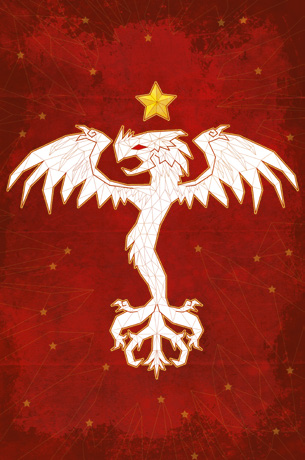
Another contender for the "way too much crap going on in the background" competition. Note the near-invisible lines that all the small stars are connected to.
History
The League was formed in 302 by Paul Devraverit from the Falkland community in response to the expansionist Hatteras station starting a war of conquest against their neighbours. To counter the overwhelming firepower of the Hatteras ships, the League formed a doctrine of stealth, ambushes and boarding actions, together with technological innovation, inventing the Tarantula, Manta and Sleeper type ships. The League could not prevent Hatteras from occupying many of the northern settlements but with each one they took, their supply lines became more and more vulnerable to League guerillas until 339, when the Hatteras could make no more advances without losing territory behind their lines and a treaty was signed. Devraverit had died during the war with no successor so in 340 a great council with ambassadors from all the League's member states was held in Nazca, the station that would later become the League's capital. The ambassadors agreed to merge their stations into one larger nation, changing the Red League from an alliance to a single state and war hero Bjorn Urik was chosen as it's leader, the First Citizen.
Urik embarked on a great project of economic modernisation, turning the newly minted nation into the richest one in the world. With this new wealth, the navy was refit to be able to fight enemy forces head on instead of being confined to hit & run actions. Though not quite able to match Hatteras, the new fleet turned the Red League into one of the stronger underwater powers. Two major problems remained though, a food supply and decreasing birth rate. Food was eventually solved by allying with the Coral Republic but the League's population has never stopped shrinking. Urik tried to remedy the latter by devoting large amounts of resources to genetic research and privileges for large families, as well as ordering all fertile citizen in the armed forces to be transferred to non-combatant roles. Urik retired in 360, transferring the League's leadership to his son Groendald Urik on the same day that the Hegemony discovered the first Genetician depot. Rumours spread that the depot held the secret to reverse infertility and after convening with the leaders of hundreds of independent settlements and minor states, Groendald declared war on the Hegemony. The first year of the war yielded great results but then the Hegemony's hyperalloy ships started appearing on the front lines and the situation was reversed. The Hegemony stormed the League capital of Nazca in 370, first capturing and enslaving all fertile citizen there and then destroying it completely. Hegemonic commandos also tracked down and killed or captured all members of Groendald's family.
After the great defeat, the Red League was forced to sue for peace but Groendald and the fleet reverted to guerilla tactics and secretly continued to support the many enemies of the Hegemony against the conquerors. Settlements about to fall were instructed to comply with the invaders demand to prevent the destruction of their industrial resources. In 373, the Coral Republic joined the war and helped push the Hegemony out of the League's territory, which resulted in the League capturing many hyperalloy and Techno-Hybrid producing facilities built in the occupied stations. In 375, a rift formed between Groendald and Piotr Devrac of the Coral Republic, with Groendald wanting to push onwards and destroy the evil that was the Hegemony and Devrac preferring to negotiate on the neutral grounds of Equinox. Groendald, who had fallen into depression and paranoia following the murder of his family, saw this as a betrayal and a plan for the Coral Republic to take over both warring nations. Against the recommendation of his entire staff, he secretly contacted the High Admiral of the Hegemony for a truce and an alliance against the Cult of the Trident. After the destruction of both the Hegemony and the Red League's fleet at Equinox, Groendald declared war on the Coral Republic but was quickly overthrown by his staff, who sued for peace and attended the Admiral's Council.
In the century of peace that followed, the Red League once again became the strongest economic power beneath the waves and in 468, a new agreement was signed with the Hegemony, allowing for the return of Aaron Urik, Groendald's great-grandson, born as a prisoner from the descendants of the Urik family members captured in the attack on Nazca. Aaron became the next First Citizen in 474 and pursued a policy of ending the cold war that still persisted between the League and the Hegemony. The greatest problem facing the league now is still infertility, it's population shrinkage accelerated by the casualties in the past wars and the kidnapping of fertile individuals by the Hegemony. Unwilling to implement the inhumane reproduction policies of their rival, the Red League's numbers are still in decline. In 567 tensions flared up again with the Hegemony's invasion of Fuego Liberdad, with the League's intelligence services believing that they would be the next target. A plan for an overland strike was prepared titled Operation Minos but the Hegemony backed down after raiding a Genetician vault in Fuego Liberdad and made no more offensive moves against the League. Still, the current First Citizen, Aaron's son Khan Urik, no longer believes in peace and is preparing for a war against the Hegemony.
The book can't keep it's backstory straight, now the Coral Republic isn't a neutral third party in the second large Hegemony - Red League war but an active participant. Spoiler: This won't be the last time that happens. That said, let's continue with the Red League.
Society
The League numbers 22 million souls, although that number is dropping, with too few fertile citizen remaining to keep the birth rate up. The few that remain are cherished and given special privileges, with births being reasons for great celebration, though they are forbidden from serving in the army or any other hazardous occupations. The parliament devotes massive amounts of resources to finding a cure for the infertility and there are also rumours that the League contracts pirates to kidnap fertile people from elsewhere. League citizen enjoy more freedom than those of most other nations and the largest religion is the Cult of the Trident. Fringe opposition groups call for a more stringent reproductive policy, citing the Hegemony as an example but the Parliament has spent the last 150 years telling them to fuck off and move to Bermuda already if they like slavery and rape that much. The League is the richest state on earth at the moment due to it's large mineral reserves of Cylast and tri-terranium, massive commercial fleets and the largest amount of surface installations of any nation, though the latter are outclassed by the Hegemony's less numerous but individually larger ones.
The League is ruled by the Parliament of the League, consisting of one representative from each constituent station and it's spokesman, the First Citizen, Khan Urik. Urik is also the commander in chief of the League's armies. In times of war, full power is granted to the First Citizen. The Coordinator is in charge of national security, who leads the intelligence, counter-espionage and civil security forces, named the Red Guards. The Maigar leads all the League's research efforts and the Great Procurator manages the legal services and the wheeling and dealing of the commercial sector. The league's social structure is divided roughly by wealth, with the directors of the largest companies at the top, followed by senior managers and executives. Next is the large and comfortable middle class, which is made up out of the armed forces and the low ranking employees of the League's great commercial sector. A small underclass exists as it does anywhere else but the Great Procurator makes sure there's always somebody hiring. Mercenaries and fertile citizen are outside the hierarchy but are treated with respect, as they secure the League's borders and it's future respectively.
Next: Red League territory, armed forces, characters and stations.
Book 1, Chapter 1: The World of the Deep, section 1.2: Civilizations of the Deep
Original SA post
Polaris RPG(2016)
Part 7, Book 1, Chapter 1: The World of the Deep, section 1.2: Civilizations of the Deep
Still with the League here but we're already halfway through, the Hegemony is uniquely long in terms of writing.
Territory
The league's core territory consists of a line of cliffside cities built into the underwater parts of the Andes mountains. The largest of these is the capital Nazca, which spreads out over a diameter of 30 kilometers, and has 6 floors in the ocean and 12 buried into the mountainside. The book considers these numbers very important you see(Nazca also has nine times the surface area of Keryss, which the book previously said was the largest city under the ocean. Don't throw numbers at readers if your math is garbage, book. Cities much larger than Keryss in a variety of ways will be a running theme throughout this chapter) Nazca is surrounded by hangars for the League's gigantic commercial fleets and also their only significant farming installation. Most other stations are located off the continental shelf and built more conventionally with above ground pressure vessels. The League hasn't developed the extensive tunnel network of the Hegemony, only connecting the main cities along the Andes. Recently, construction has started on tunnelling through the Andes towards the Hegemony with the goal of connecting to their tunnel system and establish a connection with Equinox on the far side. The league owns many mineral extraction sites, with the entire Peruvian trench turning out to be loaded with Cylast and tri-terranium. The League has little in the way of agriculture outside the Nazca metropolitan area and imports nearly all it's food from the Coral Republic.
Armed Forces
The League maintains a navy of old and outdated cruisers in various states of disrepair, most money being redirected to genetic research, which is compensated in part by their massive numbers. Mercenaries make up the bulk of of their forces, with the League only directly owning a small section of their fleet. Rather than committing their vulnerable cruisers, the League prefers swarm tactics and ambushes with many escorts and frigates. Their underwater infantry is mostly standard although they lack the Hegemony's many sea-floor based tanks, instead being supported by Tarantula and Manta fighter craft. Below ground and on the surface is where the League really shines, with their elite forces trained and equipped to be on par with the Hegemony, if not better. The League has very little domestic arms industry and imports mostly from other states, most recently placing an order for several ultra modern cruisers from the Coral Republic.
Personalities
-Khan Urik
The First Citizen and spokesman for the Parliament of the League. Currently 71 years of age and obsessed with finding a cure for humanity infertility. Doesn't consider the Hegemony inherently hostile but thinks they should be contained when they're feeling expansionist(the Hegemony has never not been expansionist for the entirety of their existence so I guess this is a polite way of saying he does hates them forever?). Currently hunting a pirate named Seyard the Damned, who his spies inform him has critical information on how to reverse the infertility condition.
-Veliador Viper
Urik's appointed heir. 31 year old and a member of the Cult of the Trident. Viper is a natural leader and strong of character so most of the League's citizen are ok with this. Another plus is that he's fertile and thus able to establish a dynasty, something the League considers important due to owing their continued existence to several Uriks. Some say he is not the pacifist his faith expects him to be but secretly a megalomaniac.
-Alma Terrack
The 60 year old leader of Cliastro, the League's largest mining company. Incredibly influential but suspected to be linked to several notorious pirates.
-Kaleed Gradest
The League's greatest scientist, leading the Renaissance research project studying the sterility crisis. Possessed of a practically superhuman intelligence, this 16 year old is the League's most heavily guarded individual, having been targeted by a great many kidnapping attempts. Dead end metaplot reference count: 9
-Olaf Faltor
The League's ambassador in Equinox. Born without eyes and with several other hideous deformities(the latter wasn't communicated to whoever drew his character art) but nevertheless well respected by all. A true diplomat, his ideal future would be to unite all of humanity. Despite his lack of eyes he can read people as no other, able to always tell truth from lies, his voice hypnotizes those who listen to it and it is whispered he possesses even greater gifts. Dead end metaplot reference count: 10
-Karl Edgesteel
The Great Admiral of the League, and permanently occupied with requesting a larger budget. Sorry bro, you're not clearly part of the metaplot like Kaleed or Olaf so you'll have to make do with what you have. Doesn't believe the Hegemony's official stance of non-aggression for a single second and is suspected of trying to engineer a diplomatic incident that would reveal their insincerity. Has the ear of the First Citizen and is often seen together with Urik.
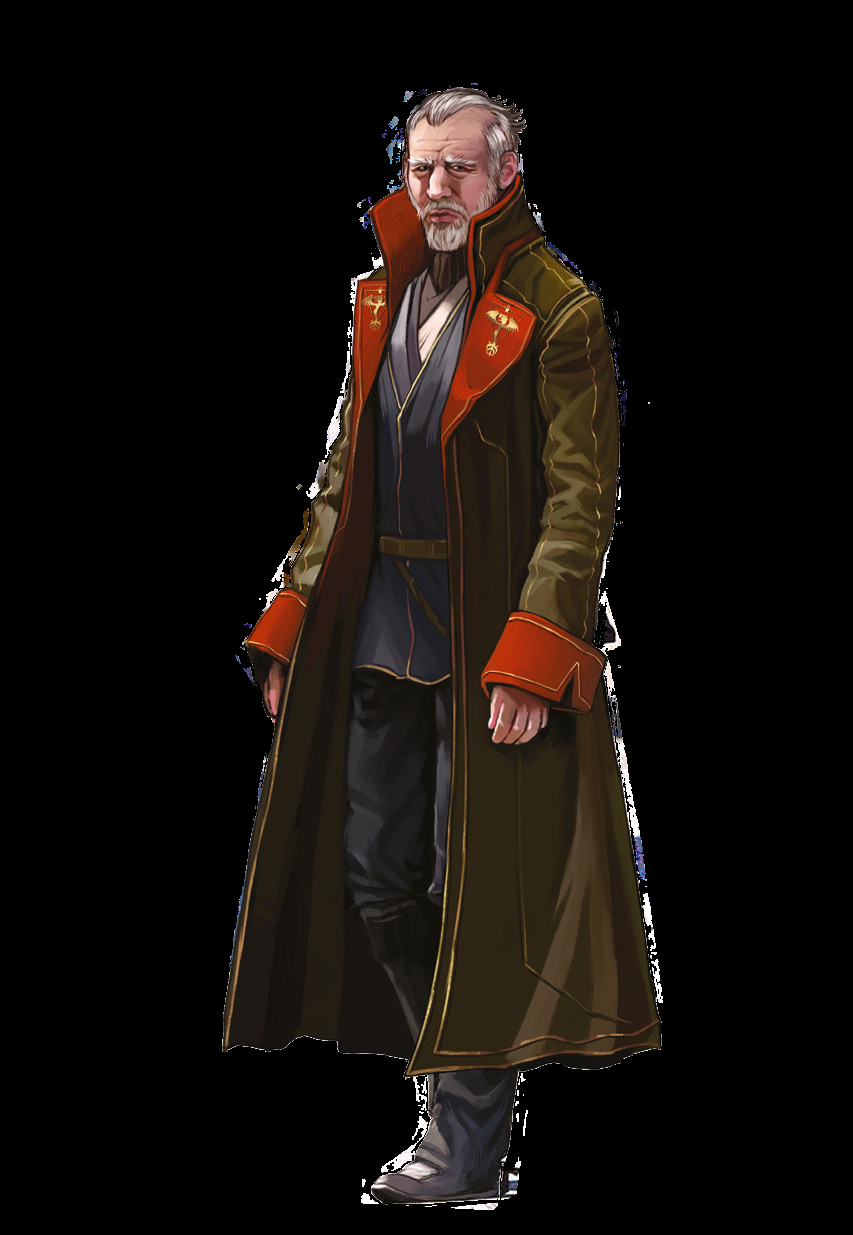
Khan Urik. No idea what is going on with the edges here, it looks fine in the pdf.
Stations
Chiloe
Population: 650.000
Depth: -286m
Fertile population: 13%
Mutant population: 56%
Chiloe is actually a long line of smaller stations connected together along the edge of the Peru-Chile Trench where they extract geothermal energy. It also runs the energy stations along the Chile Ridge, hundreds of kilometers away. The Chiloe station's mutant population keeps growing, although nobody knows why and while they are safe from burrowers, they are constantly harassed by aquatic and even amphibious predators from the Andes mountains for no discernible reason. Chiloe is connected by tunnels to Cruz and Leis. Note that Cruz is located nowhere near the Andes where the previous page said the League's only major tunnels are.
Cruz
Population: 192.000
Depth: -456 m
Fertile population: 11%
Mutant population: 29%
Cruz is Oneral's twin city and virtually identical in all respects. This means that we can defer actually describing the station to later and leave this a useless stub entry! Lacking city description aside, Cruz has a issue with the Proteus infiltrating the populace. What's a Proteus? Good you ask, we'll get to that in approximately 450 pages when we get to the bestiary. Jumping ahead a bit, they appear to be oozes that can take the shape of those they devour. The station is currently on lockdown and all new arrivals are interrogated at length, suggesting the problem has more to do with spies than blob monsters. Cruz is linked to Chiloe and Oneral by tunnels. Oneral is also not located along the Andes.
Leis
Population: 880.000
Depth: -6.000 m
Fertile population: 16%
Mutant population: 28%
Leis is a major industrial city built into the sides of the Andes. It's underground wards are a constant battleground against the Burrowers but despite this, many commercial companies have their headquarters here. It is a dark and dreary city but it's inhabitants are hard workers. Located here as well are several access shafts leading to the surface, where most of the League's automated factories are located. For some reason the book didn't think those would be important to mention anywhere other than halfway through the list o' places. Leis is the largest transport tunnel hub in the Red League, connecting to Chiloe, Oneral and Nazca
Nazca
Population: 13 million
Depth: -2000 to -7.600 m
Fertile population: 12%
Mutant population: 30%
Nazca is built into the sunken sides of the Andes mountain range and spread out all the way to the far side of the Peru-Chile Trench, where a 30 km diameter structure has been built, surrounded by hangars and agricultural stations. The trench has an average depth of 8.000 meters and a maximum of 18.000 meters and it is where the world's richest veins of Cylast and tri-terranium are located. Oceanographer's note: The book never tells you but at some point during apocalypses one through three a great tectonic upheaval must've taken place because the depths given for all trenches are often completely out of whack. That or Tessier has confused feet and meters somewhere. Burrowers contest this whole region and special underground commandos are always fighting to keep them at bay but are hampered by poor and outdated equipment. Wait, I thought the book said the League has the best underground and surface troops just two pages ago. Polaris! :aaargh: Nazca is connected to Leis and Oneral by tunnels.
Oneral
Population: 160.00
Depth: -856 m
Fertile population: 12%
Mutant population: 12%
Oneral is built into the submerged remains of lsla San Félix, here misspelled San Felix. It is a gigantic industrial city and it's mines reach down to 10.000 meters. Like Leis, many League companies have headquarters there. The city's quality of life is low. Everything is grey, cold and badly repaired though the inhabitants are hospitable and greet outsiders with courtesy and warmth. Tunnels from Oneral go to it's twin city Cruz and Leis
Vrama
Population: 86.000
Fertile population: 10%
Mutant population: 23%
Depth: -2.050 m
Vrama's depth is listed after it's demographics, the only station in the book for which this is the case. Editing! It's a major industry and trade hub between the Red League and the Coral Republic. It operates several mobile energy stations that drift along the ridges and fracture zones in the area and is constantly under attack by predatory creatures like Chiloe
Next: The Polar Alliance
Book 1, Chapter 1: The World of the Deep, section 1.2: Civilizations of the Deep
Original SA post
Polaris RPG(2016)
Part 8, Book 1, Chapter 1: The World of the Deep, section 1.2: Civilizations of the Deep
After a week of real life-isms taking up time, Polaris is back! Let's jump straight into the
The Polar Alliance
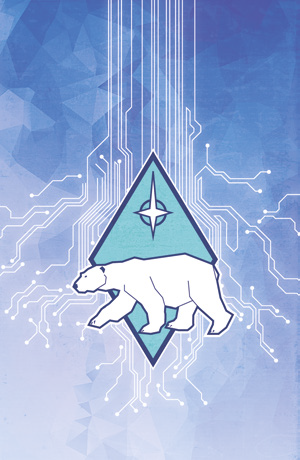
I feel as if the flag designer for these was paid by the hour. It's the only way that these overcomplicated monstrosities make any sense.
The Polar Alliance lives where you'd expect them to based on their name and flag. Their territory is sparsely populated and you probably won't realize you're in it until you encounter one of their major settlements.
History:
The Alliance started with Paul Quercy, an insane explorer who headed into the frozen north that few thought was worth colonizing. He found enough tri-terranium for some minor extraction settlements to carve out a living but nothing real came of the territory until the year 400, when Quercy discovered a giant cave tens of kilometers across inside the Arlis seamount ridge, filled with bioluminescent and and oxygen producing plants, centered around a lake where marine mammals gathered and reproduced. Despite some initial friction with the animals(remember that they're sentient and wizards, though the book won't outright state that until the bestiary at the end of book 2), who were wary about some weird apes building highrises around their sex club, the cave was immediately colonized and turned into a major agricultural station. Even better, in 408 it turned out that the glowing plants were actually biological machines created by the Geneticians and that deeper down the caverns there was a Genetician research station for biomechanical science and artificial intelligence, exploration of which which would later result in the creation of androids and cyborgs in 543.
Over the course of the 5th century, Arlis developed it's new technology in secret until 512 when it linked up with several outlying communities and officially formed the Polar Alliance under Primarch Alexander. Next came another 50 years of isolationism until 568 when it allied with the Hegemony to join in on the invasion of the Coral Repubic(wait what? When did this happen? Is this an editing error that was meant to say Fuego Liberdad?) but flubbed their contribution by having it's entire fleet destroyed by pirates at the battle of the Lau-Havre Through(which is near the Coral Republic so that is where they were going but the book never though to mention this new war before in the Hegemony sub sub chapter and it won't be mentioned again the Coral Republic section). At around the same time the Hegemony cancels the Exeter Directive, their alleged secret weapon, with no explanation, resulting a failure of the invasion. Alexander and Viramis both blame the other for being the deciding factor in the defeat and tensions have been high between the Alliance and the Hegemony ever since. Most recently, the Leviathan Community wiped out an Alliance fleet that passed too close to their territory. Although technically the party at fault, the Primarch is considering a retaliatory action.
Society
The Polar Alliance's population of two million is split between about 600.000 chosen ones who are allowed to live in the capital of Arlis and the rest, a lower class that mainly operates the mining sites in the Arctic ocean. The inhabitants of Arlis are all either fertile or scientists working on the Genetician base with the fertile citizen living in the main garden cavern and the scientists down below near the research station. The latter area is completely off limits to outsiders and is also where the Alliance's sole ruler, the Primarch resides. The Alliance shuns political opponents of the Primarch and mutants, sending them out to the mining bases or conscripting them into the army at best and banishing them to the surface at worst, leading to no small amount of discontent among the population. The inhabitants of the outer stations of the Polar Alliance rarely if ever get admitted into Arlis and are charged with resource extraction. The Primarch protects them from outsiders with his androids and cyborgs which act as peace keepers and in return they handle trade with other nations. Life standards outside Arlis are low and the population owes their survival more to their own resourcefulness than to the meager rations the Primarch sends them from the farming caverns.
Territory
The Polar Alliance is fairly small with only eight cities and 30 mining settlements. The capital is built inside the undersea mountains of Arlis. The upper level houses a great garden, many farms and luxurious houses for the Alliance's elite citizen, the fertile and those workers lucky enough to be chosen to maintain the cavern rather than toil in the mines elsewhere. The lake at the center of the cavern serves as a breeding ground all kinds of marine mammals except for orcas. Orcas are dicks and don't get along with other cetaceans as we'll learn in the bestiary. Below that are the research centers and laboratories are, as well as the Patriarch's own residence. Nobody from outside the city has ever been down here and the only way into the city are two 12 kilometer long tunnels lined with defensive installations. Surrounding the city are more defense stations, factories and ship hangars. Outside the capital the Polar Alliance has only conventional undersea stations focussed on extracting Cylast(the previous page said the Alliance mines tri-terranium instead).
Armed Forces
Although badly depleted due to recent events, the Alliance is still kept strong due to two natural advances, the first of which being that the capital is practically invulnerable from harm due to it's position behind narrow choke points and many defensive structures. Going by the size figures given for them, a Hegemonic Altantis flat out won't fit through the tunnels. The second are their cyborgs and androids, which make up their special forces due to their unbreakable morale, superhuman reflexes and advanced tactics learning algorithms(which doesn't exactly explain how they get wrecked each time they move out from their borders). Polar Alliance cruisers are smaller than other nations but carry heavier armament for their size. Aside from it's cruiser the Alliance also operates a special forces unit called Spectra division, which is exclusively made up out of cyborgs engineered to operate at high pressure and low oxygen levels inside special frigates. These same qualities makes them good infantry too, which also uses them extensively. The Polar Alliance has 10 total Vulcan-class heavy cruisers, each the flagship of a patrol that protects one of the Alliance's 10 regions. A patrol consists of 1 cruiser, 6 Starlight-class destroyers, 12 Wraith-class frigates, troop transports and drone deployment ships. Fleet officers are exclusively from Arlis, troops and seamen from the outlying territories.
Personalities
-Primarch Alexander
The Supreme Leader of the Polar Alliance has not been seen in public for 10 years, communicating only through the Scientific Council or an android named Alpha. He lives secluded in the lowest levels of Arlis and is a despot who tolerates no opposition. Nobody outside his country likes him. Not many inside do either.
-Alpha
Alexander's android mouthpiece among the population that lives in the garden city of Arlis' upper level. It seems perfectly human in appearance and exhibits human behaviours but never shows any emotion. Rumours are spreading that Alpha doesn't speak for the Primarch and is ruling by itself.
-Ember Krystchef
Ex mercenary in his forties, current commander of the Polar Alliance fleets. Excellent officer and good strategist but considers the Polar Alliance's strong and versatile androids and cyborgs to be mere cannon fodder and will argue against their use at every available opportunity. So far the Primarch has not given heed to his warnings. Over the course of his tenure, Krystchef has thrown eight of his personal assistant androids out of his flagship's airlock.
-Paolus
Ambassador of the Alliance in Equinox. Doesn't show any emotions, leading to rumours about his potential lack of humanity. Is blatantly an android according to his official art and doesn't even remotely pass for a human. They have
-Professor Helm Garrad
Head of the intelligence services, in his fifties. Curious that the Polar Alliance npc's get no exact ages given while other nations do. Disliked by anybody who ever met him.
Alexander doesn't get a picture so here's the number #1 winner of the "most likely to survive the inevitable AI uprising that the book keeps hinting at but refuses to outright mention" contest, Ember Kyrstchef:
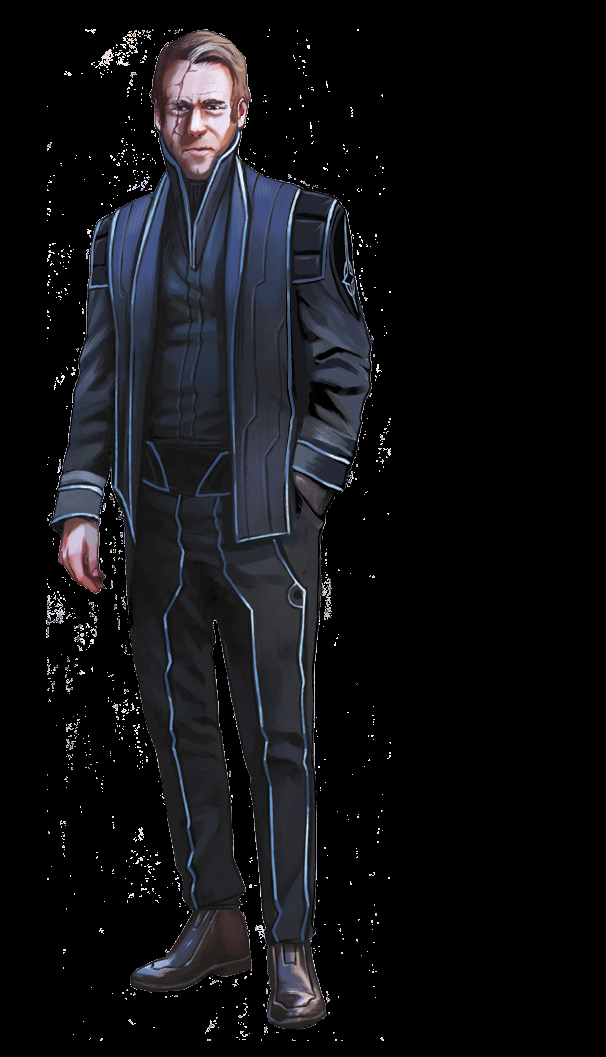
Stations
Arlis
Population: 900.000
Depth: -2.200m
Fertile population: 49%
Mutant population: 0.00%
Page 34 specifically said Arlis had 600.000 inhabitants. We're now on page 36 and that number has grown by 50% Proofreading! While I'm at it, remember that big ass dome in Keryss, the "largest city under the ocean"? Well Arlis, despite only having 5% of it's population has a bigger one. With the latest revision it it's population numbers, the upper level is now off limits to outsiders as well. It is still exclusive to the societal elites, but the cetecean boning zone has expanded to be multiple lakes as well. New here is that the city is on the front lines with the Burrowers and despite tensions with the Hegemony, Alexander has sent them an emissary to obtain more weapons to fight them. The Polar Alliance also doesn't use those fucking tunnels that would be way better explained with a single map than individually listing each station's connections so yay.
Barrow
Population: 60.000
Depth: -250m
Fertile population: 23%
Mutant population: 34%
This city is similar to Leonid, which is again, a town the game hasn't discussed yet. Barrow is the public facing part of the Polar Alliance where quality of life is higher than other stations due to trade with the Hegemony. Android presence is kept behind the scenes here and visitors are allowed.
Iagna
Population: 300.000
Depth: -225 to -350m
Fertile population: 10%
Mutant population: 20%
Iagna is a dreary and oppressive resource extraction camp where the inhabitants toil away in the mines beneath the emotionless stares of security androids and management that they never see. Mutants are treated as disposable slave labour despite protests and whispers of a rebellion forming.
Leonid
Population: 48.000
Depth: -250 to 350m
Fertile population: 12%
Mutant population: 42%
Leonid is a fortress city protecting the Bering Strait and supplying the four defense stations surrounding it. From here the Polar Alliance's surface sites are accessed and there are rumours that mutants are exiled from here with little or no equipment to survive on the surface. In other words, it bears no resemblance to Barrow at all.
Oursa
Population: 36.000
Depth: -225m
Fertile population: 23%
Mutant population: 6%
A generic city that recently had a failed rebel uprising. There are reports of the sector's fleet snooping around here but diplomats are swearing high and low that those are just exercises. Tensions are mounting anyway.
Siberia
Population: 65.000
Depth: -300 to -350m
Fertile population: 11%
Mutant population: 23%
Another average community, this time at war with orcas. Currently losing but Spectra Division forces have just arrived and could easily swing the balance. The SMSO dislikes this situation and is likely to soon sanction the Polar Alliance over this war.
Up next: the Coral Republic
Book 1, Chapter 1: The World of the Deep, section 1.2: Civilizations of the Deep
Original SA post
Polaris RPG(2016)
Part 9, Book 1, Chapter 1: The World of the Deep, section 1.2: Civilizations of the Deep
We're halfway through the major nations. Our next one will be the second longest one after the Hegemony and the thing longest piece of background overall, behind the Hegemony and the independent stations, which take up 12 full pages but that's a matter for the future. For now, we''ll be visiting the setting's Protagonistan which is the best at everything and where all cool and good things come from with...
The Coral Republic
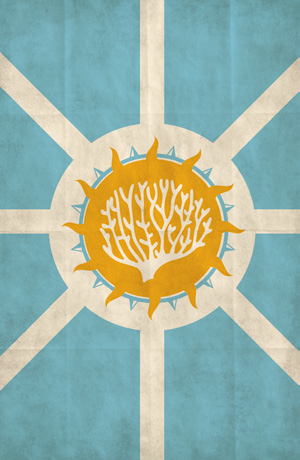
And they even have a flag without a trillion tiny background detail, even if their main crest is still a little messy.
The Coral republic lives in and around Australia. It's entire territory is covered by it's namesake polyp colonies(that are also wizards) and modern communication systems.
History
The Coral Republic is the oldest nation in the world, starting out as being the breadbasket for the Genetician Empire with it's livable climate and many agricultural stations. After their fall, the Azure Alliance established their capital, the imaginatively named Azuria, here as well, which remains the world's most beautiful city to this day. When the Alliance fell apart, Azuria was the last city to remain a part of it and eventually renamed the entire region Coral, after it's predominant terrain feature(no shit). The next 18 years are spent fending off pirates coming to loot the riches of the old Alliance until 268, when the coral becomes strong enough to destroy invading ships. With their homeland secured, the Republic goes on the offense and the High Council promotes politician an former pirate William Gallasteno to the leader of the Coral Fleet. He reforms the military to small, mobile combat groups and relegates the Republic's capital ships to protecting cities and offered carefully selected pirate kingdoms along the Ring of Fire an alliance in exchange for their help with dealing with their neighbours. This plan is a wild success and in ten years, fully 15 pirate states are destroyed or outright absorbed into the Republic and a little bit later in 282, Gallasteno was elected Council president at age 59.
The good times didn't last however and after the remaining pirates had a civil war amongst themselves they united against the Republic, starting with the assassination of two admirals, five councillors and Gallasteno in 284, followed six days later by a full scale invasion. The war raged for 12 years, including the destruction of Azuria(you may notice that this is not what the book said about Azuria's history less than a page ago) and most of the Republic's coral until 12 February 296 when pirate fleet suddenly found themselves under attack from an unknown source that disabled their sensors and jammed their communications. This attacker turned out to be the coral itself(note: this is not even remotely what coral does according to the
Travelling back in time to 333, Alec Fanstorm receives word from the spokesperson for the Coral that it has been exhausted by it's intensive use of it's powers and can't sustain them much longer. In response, Fanstorm started a large rearmament program for the fleet and hired the first of what would be the Republic's many mercenary units. The Coral gradually scaled back the use of it's wizard powers as more Republic ships were built until 359, when it reached current levels. Alec Fanstorm was replaced by Helena Triasse, a mutant and scientist who discovered a workaround for the sterility virus so blatantly fucking obvious that it makes everybody else's ideas like the Hegemony rape prisons entirely pointless: Cloning people.
Yes, really. It's not a secret and they've been doing it for 200 years with success. There's no reason for anybody else to not copy it and use it instead of whatever bullshit they themselves have going on. Oh and the Coral also told her how to transplant chunks of it into both humans and machines so everybody from the Coral Republic and all their stuff is straight up better than everybody else. These inventions caused a population surge not seen since before the first apocalypse and revolutionized science in the Republic though at the start of the seventh century, these advances would still prove insufficient to save humanity. Welp, guess there's a fourth apocalypse scheduled 30 years into the future. Dead end metaplot reference count: 11. "Today" in 566(note: 566 is not the setting's "present day"), Coral is an integral part of everyday life in the Republic.
Back to the year 360, a treaty was signed with the Red League(Red League section disagrees and says somewhere between 340 and 356), trading food for minerals, which the Republic has a hard time extracting because of it's omnipresent Coral and the Republic fleets fought together with the League against the Hegemony until 375 when the League broke off the treaty. Admiral Piotr Devrac got tired of Urik's paranoid behaviour, the civilian massacres on both sides(earlier in the book this was a Hegemony only thing) and he needed to teach the pirate states back home another lesson so with the Parliament''s support(wait what happened to the Council?), he joined the Cult of the Trident and invited the fleets of the warring powers to a showdown at Equinox. Nobody knows what exactly the connection between the Cult of the Trident and the Coral Republic was that caused this deal to happen, since the latter worships it's wizard invertebrates and not magic itself like the Cult does.
After Devrac's wildly successful plot, the Republic's last remaining problem were pirates that had discovered how to sneak across the Coral fields without waking it up and getting annihilated. The Republic used this time to expand their agricultural industry and become the world's largest food producer, as well as finally convincing the Coral to move it's ass and vacate the mining sites, followed around 500 by expanding their operations to establishing mining bases on the surface. In 544, the current leader of the Republic, a mutant named Laelia Trenton was elected, focussing mainly on trade and international cooperation. She is the most important person of yet another hitherto unmentioned Equinox institution that will never come up again, the Equinox Council, which advocates merging all human into one big alliance to combat some unknown threat in the future. You know, completely unlike the three other Eqiunox based pan-human circlejerks. Dead end metaplot reference count: 12.
The Republic stayed relatively quiet aside from the occasional pirate raid until 568, when weird shit started happening. First a pirate named Red Hand Meslar made a shocking discovery aboard a Coralian ship owned by the research company Palia. The authorities destroyed the ship and Meslar is now the most wanted man in the Republic. Word on the street, and among the intelligence headquarters of other nations is that the cloning experiments involving Coral have resulted in a discovery that might destabilize the entire world. Dead end metaplot reference count: 13. Palia and another company called Cortex have been discovered to be involved with several notorious pirates, paying them to capture human test subjects for mysterious experiments. Finally, towards the end of 568, a curious illness has started spreading through the Republic's ports, which causes it's victims to be found completely dessicated, as if affected by accelerated aging. Dead end metaplot reference count: 14.
Society
The Coral Republic is the odd one out of all major underwater societies with a severe gender imbalance among it's 127 million inhabitants caused their cloning program being mainly aimed at woman due to fertile wombs being the largest population growth bottleneck and now that they've overcome it, they have the fastest growing population of any nation. They're also the most tolerant to mutants and thus have the highest ratio of those too. The upper class is formed by Coral empaths who wield no official power though the Coral's words carry great weight in the Parliament, the Republic's governing body. The Parliament elects a president and issues recommendations for the city governors to follow, which, when not instructed otherwise, are free to rule their cities as they wish, resulting in a highly diverse society. The Parliament also directly oversees the Intelligence Bureau, which handles security, espionage and counter-espionage though it's action department called Fragment, the Special Research Department, which handles all food and medical research, the Polyphemus Department, which does military stuff and is the black sheep on the bunch due to the presence of the Coral and mercenaries, the External Relations Department, which is where foreign diplomacy happens and finally the Genetics Division which is in charge of Ctrl+C babby Ctrl+V babby.
Coralian citizen live pleasant lives with the world's best healthcare, high food security and no weird dictatorships ruling over them(though the means by which Parliament is elected is curiously absent from the book...). Most of it's male population is polyamorous due to the gender imbalance and mutants have equal rights to regular humans. The Republic's largest internal issue is a steady increase in crime and it is suggested that the issue would be solved if the fleet stops trying to annex pirate stations into the nation.
Next time: the other half of the Coral Republic section.
e: sentence got cut off
Book 1, Chapter 1: The World of the Deep, section 1.2: Civilizations of the Deep
Original SA post
Polaris RPG(2016)
Part 10, Book 1, Chapter 1: The World of the Deep, section 1.2: Civilizations of the Deep
To break up Tessier's unrelenting tide of verbosity over consistency when it comes to fluff, I'll be splicing in me trying to make a character out of the book's 122 pages of chargen rules that are spread out over both books. I'll be taking suggestions from the thread but the system is quite restrictive so I'll see what I can do.
Because they're only mentioned tangentially in the world building, here's our race options:
Humans, which include lesser mutants
Natural-Hybrids, merfolk mutants. Exhaustive list of career options: -living outside society, -Wizard UN's merfolk peacekeeping division, -getting dissected for science
Geno-Hybrids, more merfolk. Created specifically by the Wizard UN for their merfolk peacekeeping division, which also happens to be their only career option
Techno-Hybrids, you got dragged out of your bed by the Hegemony and swam out of their black site as a cyborg merman slave soldier. Careers: -slave soldier -fugitive
Wizards, spectacular levels of bullshit in both directions. Career options: -UN Wizard, -fugitive hedge mage(read: a Human who wasted a lot of feats on toys they can't use)
Nationality is far less important, giving only the skills Native Language(itself) and Knowledge of a Nation/Organisation(also itself). For reference the two major powers who's society we haven't seen yet are the Mediterranean Union(team
 ) and the Cult of the Trident(they run the setting's designated Big City Adventures town).
) and the Cult of the Trident(they run the setting's designated Big City Adventures town).For now, let's continue where we left off with the Coral Republic's territory, armed forces, personalities and major cities
Territory
All cities in the Coral republic are more beautiful than their counterparts elsewhere in the world, Azuria doubly so. Instead of a single giant dome that other cities have(actually only Keryss does that), Azuria is built partially into a field of bioluminescent Coral which is shaped into huge spires to form semi-organic high rises that reach almost to the surface and branching out to form bridges between the towers. The other half of the city is built underground and spreads out further, connecting it with the many surrounding farms, military bases and ship hangars. The Republic's other 28 major and 100 minor cities are built more conventionally and typically set into the sides of the abyssal trenches. The defining feature of it's territory is it's namesake Coral, which emits a psychic field absorbing harmful UV radiation from the surface and protecting the Republic's primarily photic/mesopelagic cities from it(The book told us that those cities were located in the abyssal zone just three sentences ago!). The Coral is concious, speaking through human empaths and also defends the Republic by jamming enemy sensor and communications(the vehicle rules still say it just psychically fries the brains of intruders). It can also grow to any depth as long as it's connected to a patch near the surface absorbing UV, proving that Tessier has no idea of what coral actually is.
Armed Forces
The Republic's fleet is mostly second hand light ships modified to have more Coral growing on them and thus be better(so where exactly are these hyper modern heavy cruisers that the Red League is buying from the Republic coming from?). Likewise their infantry is kept to the bare minimum and the Republic prefers waiting for their enemies to kill themselves against the Coral or just throw mercenaries at the problem though lately Parliament has suggested the Republic needs some more offensive punch.
Personalities
-Laelia Trenton
A mutant born without a larynx that only speaks through an interpreter and is never seen without a hood and mask. Nevertheless still managed to get to be President of the Parliament and be quite well liked at that. Trenton is 50 years old and her interpreter 31, who is also very beautiful(because all Coralians are, as the book will repeatedly remind you).
-Acinia Berrevris
Most senior Coral empath and it's advisor to the Parliament. 64 years of age, very influential.
-Elmenear Calloway
One eyed mutant and High Admiral of the Coralian fleet, Calloway is the driving force behind the upcoming reorganisation of the armed forces. 51 years old.
-Coralia Deventris
Which asshole names their poor kid after the country they're in? The Deventris family, that's who. Little Coralia sure showed them though, at 28 years of age she is now the most strikingly good looking diplomat in Equinox(why).
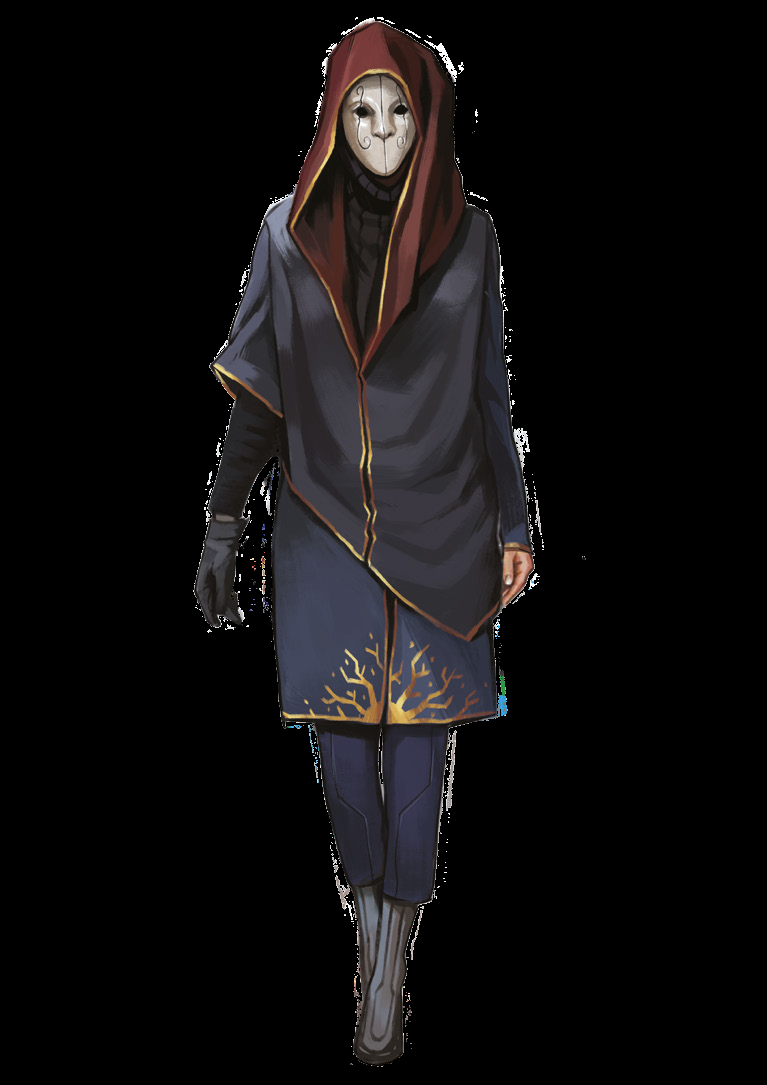
Laelia Trenton, hot interpreter not included.
Stations
Arch
Population: 9 million
Depth: -255m
Fertile population: 34%
Mutant population: 32%
Arch is a mostly underground fortress city from which the Republic sends out most of it's anti pirate expeditions. Recently damaged by an earthquake.
Azuria
Population: 27 million
Depth: -200m
Fertile population: 34%
Mutant population: 41%
The best looking city in the world where all the best looking people come from. Popular tourism destination. Also note that it is half again as populous as Keryss, the "biggest city in the ocean".
Cape
Population: 834.000
Depth: -200 to -3.000m
Fertile population: 28%
Mutant population: 39%
Fortress city and trading hub. The Republic's trade routes go through here and there's constant conflict with pirates.
Corallia
Population: 12 million
Depth: -100 to -200m
Fertile population: 29%
Mutant population: 49%
Identical to Azuria but smaller(so much for Azuria being totally unique). Popular place for corporate headquarters of tourism and freight companies.
Dale
Population: 8 million
Depth: -110 to -200m
Fertile population: 43%
Mutant population: 29%
Not the prettiest Coralian city, that would be Azuria
Drech
Population: 2 million
Depth: -255m
Fertile population: 23%
Mutant population: 34%
Industrial city, under quarantine by the Fourth Coralian Armada(oh now they do have a proper fleet again) because of a new plague outbreak. May or may not have the Red League ambassador trapped inside.
Erchey
Population: 1 million
Depth: -400m
Fertile population: 23%
Mutant population: 42%
Industrial city and unique in the Republic in that it isn't surrounded by large amounts of farms. Focusses on research, raw materials processing and machine production.
Fassar
Population: 9 million
Depth: -150 to -400m
Fertile population: 27%
Mutant population: 32%
Industrial and military city. The book literally tells us that there's nothing interesting here.
Kai
Population: 240.000
Depth: -255 to 1.200m
Fertile population: 10%
Mutant population: 38%
A new fortress city under construction to serve as forward bastion against pacific pirates. Construction ran into a major problem with several families of plated sharks(large aggressive predators) settling nearby which seems to be kind of a ridiculous issue considering that the Republic has 1. torpedoes 2. brain melting polyp colonies.
Númenor
Population: 7 million
Depth: -255m
Fertile population: 34%
Mutant population: 53%
The Republic's primary mining city, managing both mines in the depth and on the surface. Naturally, constantly under attack from Burrowers. As with Dale, there's no discernible reason for why it's named after a kingdom from Tolkien's works.
Ojias
Population: 4 million
Depth: -1.000m
Fertile population: 23%
Mutant population: 49%
The Republic's easternmost city and major trade hub before the great no-man's-land full of pirates and natural hazards between 160° E, 120° W, 80° S, and 40° N. First of all the book missed an opportunity to say no man's sea here and secondly, fucking coordinates, really? Three out of four corners of this area end up on land too. It's also not the republic's easternmost city, that would be Cape, nor is it anywhere near where you'd expect trade routes to Vrama to be. Nevertheless it is a major fleet base for convoy protection units for the Republic, League and the Fellowship of the Watchers(UN wizard's peacekeeping forces).
Stirling
Population: 3.445.000
Depth: -90m
Fertile population: 39%
Mutant population: 31%
A generic Republic city with lot's of farms. Not as beautiful and nice to live in as Azuria
This section ends with some in universe fiction, a message sent from a Cult of the Trident representative who recently disappeared in Corallia, talking about how good looking Coralians and their cities are but being worried about being stalked about an unseen foe. Not adding this to the metaplot cliffhanger list because it's just a faceless nameless exposition dispenser.
Next time, Equinox and the Cult of the Trident(part 1 only, part 2 is located 10 pages further in for some bizarre reason)
Book 1, Chapter 1: The World of the Deep, section 1.2: Civilizations of the Deep
Original SA post
Polaris RPG(2016)
Part 11, Book 1, Chapter 1: The World of the Deep, section 1.2: Civilizations of the Deep
The book makes you map out your character's past life up until the point they become an adventurer so the thread's rogue magician will need some background information wrt hometown size, social class, education and past places of employment. The book's selection of career options has some really arbitrary limits but I'll figure out a way to shoehorn your choices into what the book lets us.
Meanwhile, here's the first half of the Wizard UN, the faction that will be hunting our character for his/her unlicensed use of magic. The second half of their background is hidden between the minor powers and independent stations.
The Cult of the Trident
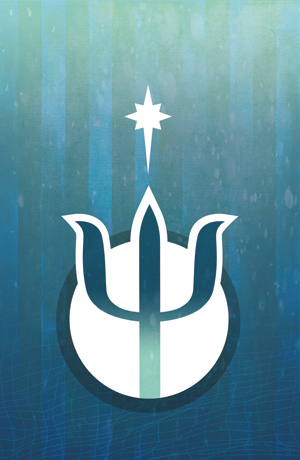
Almost a reasonable flag but then they had to go and put that wireframe stuff on the bottom.
The Cult lives around Rockhall, a curious misspelling of Rockall, made all the stranger by the fact that the French name for Rockall is also just Rockall.
History
Rock(h)all was first settled in 127 but it took until 251 for somebody to find what may or may not have been a genetician depot. It's discovery caused a heat flow to form(weird tube shaped thermoclines that have no basis in reality) and in 256, the community of Trident was formed. In 340, they upgraded to the Trident Alliance and in 348 they discovered the Polaris Effect, accidentally killing 112 people with it. A year later they decide to build the great city of Equinox in the Ariadne Trench(a fictional location as far as I can tell from google), defended by the heat flow and friendly cetaceans. Construction was crowdfunded from across the entire world, starting in 350 and finishing in 365. While this was going on in 352, Leori Arimatti hypothesised that the Polaris Effect outbursts might be caused by people and in 373 the Cult of the Trident was founded by Simon Arimatti(book doesn't say but I think that's a son) and Piotr Devrac(never mind that this guy lives on literally the opposite side of the world and was fighting a major war at the time) with Simon becoming the Cult's first Demeter(all ranks are named after classical gods/goddesses, Demeter being the title for the overall leader). The Cult became the public face of the Trident Alliance and sent out specialists across the world to gather all Polaris users.
Good times lasted until 440, during which the Sol becoming the new global currency, the S.M.S.O and the Fellowship of the Watchers were established and Ariadne became a major hub for trade and science, as well as a haven for fertile individuals. At the end of that time, somebody named Tristan Lesark threw a tantrum about the Cult's progressiveness and left with 100 cultists and a bunch of ships which returned in 448 as the Black Sun Fellowship(literally death eaters from Harry Potter). The Cult and the BSF have been at war ever since. In 560, Equinox is the greatest trade and diplomatic hub in the world(you mean it wasn't already for the past two centuries?) but 2 million people can not live together without devolving into constant free for all gang warfare(what) so the Watchers have their hands full keeping the peace in their city. To make matters worse, a spy war happened between 567 and 568 with severe effects on the Trident's security services and it's leader, Sernea(this war and it's long lasting effects are never brought up again).
Society
The Cult of the Trident recruits it's members from all across the world and does not discriminate based on gender or mutation status, serving only as a neutral institution to prevent mankind's extinction(as opposed to kidnapping and brainwashing all magic users, as was said on the previous page). The Cult is ruled by those who can control the Polaris Effect. They can be recognized by their Inhibitors, metal headgear with which they can control the side effects of their powers(imagine Psychic Hoods from Warhammer 40k redesigned by Apple) and live on the highest levels of Equinox. Demeter has six advisors all named Prometheus as well as two lower ranked underlings called Janus(spokesperson) and Nemesis(function unknown). The bulk of the Cult's 25.000 members are not wizards and are also given vaguely relevant classical mythological names, those being the Orpheus(diplomats), Lares(administrators), Vejovis(Scientists) and Hermes(missionaries). They manage the day to day affairs of Equinox and the S.M.S.O.. Aside from the official orders, there is also Neptune Division led by Sernea, who specialize in counter espionage since all major powers keep trying to infiltrate the Cult. They also control a few of the largest corporations in the world, those being Cortex(pharmaceutics), Hellion Laboratories(hybrids), Aeris(hyperfluids), Gladius(shipbuilding) and Solaris(mint). Ariadne, the second city of the Cult, is where all fertile citizens live, who are given all available luxuries in exchange for their cooperation with genetic research. Equinox itself has about 3 million inhabitants(things Tessier can't keep straight: Whole numbers below 5), mostly ordered by geography with each nation of origin clustering around their embassy though all are ruled by the Watchers.
Territory
Ariadne is located underground in the Rock(h)all Plateau while Equinox floats in the heat flow above with Ariadne being the main transit hub in and out of Equinox as the safe passages through the heat flows are constantly fluctuating. The whole area is covered by hidden Watcher stations and Ariadne is tightly segregated with it's residential sections completely off limits to outsiders. Equinox is a giant d8 four kilometers across(which means that it completely dwarfs the Keryss dome, the "largest megastructure" in the world) that floats -200 to -2.200 meters based on currents. The largest central level is surrounded entirely docking bays filled with ships from all over the word due to S.M.S.O demanding yearly visits from representatives of every single station. Six levels in either direction around those are the commercial districts where everything(and everybody) is for sale if one knows where to look. Smugglers and pirates run rampant here and the Watchers only rarely intervene, mostly only if gunfights threaten to spill over into the higher floors. Above the trade levels are four floors of embassies surrounded by luxury residential wards in the styles of the nation of origin. Above those are the quarters for the Cult members themselves while the city maintenance, production and defence systems are located below the market levels.
Armed Forces
The Cult of the Trident has no official army, relying entirely on the Fellowship of the Watchers for protection(literally not a single sentence in the book even vaguely supports the idea of the Watchers being independent from the Cult) though some whisper that Neptune Division has combat units as well. The Cult does have a large fleet of monastery ships that travel across the entire world, always escorted by Watcher warships(what is Watcher independence?).
Personalities
-Jason Helio(Demeter)
The ruler of Cult of the Trident is also their greatest wizard. He has perfect mastery over all manifestations of the Polaris effect and does not need an Inhibitor. He is 113 years old, completely emotionless and it is unknown if he is fertile or not. His opponents accuse him of using his mind control powers to influence people he meets, being behind the Shadow Ambassador(this is the only time that the book will bring up that name so I have no idea what it is) or even being a Genetician. He also has some kind of shadowy relation with the Other; that's not-Voldemort leading the not-Death Eaters over at the Black Sun Fellowship, speculation being that the Other is manifestation of his subconscious. Either way, nobody except maybe Sernea knows his motives(I'd be pretty insular too if me thinking too hard causes Wizard Hitlers to pop into existence).
-Jessica Melindros(Janus)
The 68 old intermediary between Demeter and the rest of the Cult. Talented public speaker but a shitty wizard.
-Marus Delvion(Orpheus)
Intermediate between the Cult and other nations. Good diplomat, no age given.
Lopterus(Prometheus)
Head administrator of Equinox(which would make him a Lares according to the title descriptions two pages back, what's the point of even having these titles if Tessier can't even remember what they are?) and known by the nickname "The Butcher of Equinox" due to having to make many Hard Choices™ during his reign like torching a quarter of the city's population during a plague outbreak and many bloody riot suppressions(I wonder which 40k book Tessier copied this guy from). Lopteros claims he doesn't regret any of his actions due to being too busy with managing the city to ponder morality. Lopteros is 92 years old and sterile.
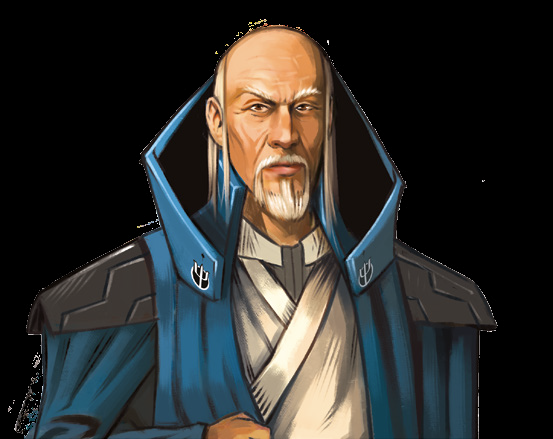
Jason Helio, who has apparently transcended the need for a full body drawing like the other faction leaders.
Stations
Carion
Population: 1.200
Depth: -300m
Fertile population: 50%
Mutant population: 99%
Carion is a leper colony for those with the Contagion mutation. Only Watchers and Cult scientists are allowed to interact with the inhabitants.
Equinox(Ariadne)
Population: variable
Depth: variable/-6.900m
Fertile population: variable/78%
Mutant population: variable
Equinox is the capital of Cult of the Trident and Ariadne is it's second city. Both are surrounded by many Watcher stations.
Pendeven
Population: 200
Depth: -3.400m
Fertile population: 19%
Mutant population: 2%
Monastery station and resupply site for monastery ships headed for the Hegemony and Red League. Rumoured to have a secret underground genetic research lab and/or training site for Neptune Division. Recently got attacked by unknown aggressors, which damaged a monastery ship.
Next time: The last of the major powers, the Mediterranean Union.
Book 1, Chapter 1: The World of the Deep, section 1.2: Civilizations of the Deep
Original SA post
Polaris RPG(2016)
Part 12, Book 1, Chapter 1: The World of the Deep, section 1.2: Civilizations of the Deep
The thread's character is almost complete and just needs a good pun for a name to get started on the chargen rules, which are a third longer than all the fluff. Speaking of which, it's time for the last(but not really because most of the Cult/Equinox stuff is hidden behind the minor powers) major nation in the book...
The Mediterranean Union

It's a flag that somebody could actually draw from memory! Wait no, there's a barely visible triangles pattern all over the background for some idiotic reason.
History
The Union started in 467 as an idea of a wealthy Galian businessman called Omar Selanko, who suggested solidifying the unofficial alliance between the local stations for the purpose of some unspecified megaproject. One problem was that the largest station, Calnais, was ruled by an asshole called baron Narwhal who, upon hearing the idea, threw a tantrum and sent assassins after all the station's leaders as well as Selanko and prepared to invade Galia in retaliation. The assassins were drawn from the Celestial Voice, a militant sect of the Heavenly Voice religion, led by the baron. Selanko survived and in 469 he discovered that Narwhal was coming back for another attempt, this time sending agents infected with mind control parasites to every station. Selanko revealed the baron's evil scheme and all the other stations responded with outrage, declaring war on Calnais(you mean they didn't already do that when the baron sent religious fanatics to kill their leaders?). On march 26, during the so called Night of Heresy they exterminate all the Heavenly Voice followers(wait if all the Voice people are dead, who named it like that?) and marched on Calnais. The allied fleets encounter the outgoing Calnais fleet just outside the settlement and after six days of fighting, Calnais and it's defenders are wiped out.
After the war, Narwhal was found in hiding near the current day city of Tamez and the main Celestial voice temple was discovered in a ruined surface city, together with a colony of the mind control parasites. The site was destroyed, the baron and his remaining followers executed and the region returned to internal bickering, even though the very first sentence of this text block stated that there was an informal alliance that had already been around for centuries. This continued until 477 when the neighbouring Empire of Ziar invaded and destroyed the frontier town of Clanaon. Ziar collapsed a few months later without doing much and got split into the Rift States and the Kingdom of the Indus but their attack finally convinced the Mediterranean factions to merge together in 478. A week before the signing of the treaty, Omar Selanko died, taking the plans for whatever he was going to build with a united Med with him to the grave. So much for that plot thread. Lesiur Narkal became the first president of newly founded Mediterranean Union, made peace with the Rift States and the Empire of Ziar(shouldn't this be the Rift States and the Kingdom of the Indus? The two mentioned do not coexist at any point in the timeline) and grew the country out to be of the major world players in under a century.
In 543 Pietrich Van Dyn became the next president, who continued following an expansionist policy and apparently sucking at it because the Union still owns nothing beyond Gribraltar or Suez. They're better at tech though, being world leaders at supercavitation and hypercavitation torpedoes, causing the other major nations to take notice and fill up the whole nation with spies to steal all their delicious delicious tech. Aside from that, there are whispers that the new religion, creatively titled the Church of the Prophet, might actually be the Heavenly Voice reformed, mind control bugs & all(that's some master grade taqiyya they've got going on there if a country populated solely by spies still can't do better than some rumors). Lastly, there's some unspecified "grave threat" looming over the Union. Dead end metaplot reference count: 15.
Society
The Union's government encourages all it's citizens to come up with new technology and to work hard. The research bureaus accept all proposals from citizen, which is how they stumbled upon supercavitation weapons and the "famous" anti-field thrower(no the book will never tell us what this is) but spend a lot of time researching garbage as well because of this. The Union has a growing population, mostly from immigrants, but even with the Council constantly funding new settlements, they're slowly running out of housing space. Said Council is the ruling body of the Union and made up out of the leaders of the 26 founding stations. Pietrich van Dyn, a well respected and charismatic statesman is it's current president. The council votes on major decisions and allocates budgets to the Union's ministries of which there are apparently "over 38" which is oddly specific and also means nothing. 39? 40? 70? 2438? The book lists the few most important ones:
-Ministry of Research, the largest and bestest one in the Union, further split into a bunch of sub-ministries, those being Synar Department(pharmaceuticals and genetics), Omar Department(industry), Nexus Department(military), Antares Department (space), Yrix Department(electronics) and Rea Department(agriculture)
-Ministry of Industry, which does exactly what you think it does
-Ministry of Colonization, which in addition to being the nationwide zoning board, is also in charge of surface and underground outposts as if that somehow makes sense
-Ministry of Defence, they distribute budgets to the armed forces and nothing else
-Ministry of Security, which is another one of those institutes split up into vaguely thematically named subsections, those being Ulysses Division(intelligence), Agamemnon(counterespionage) and Aea(police)
-Ministry of Education and Demographics, also known as Priapus(of all the fucking things they named the school board after an ancient dick joke) which is in charge of the education system and reproductive programs
Officially there are no social classes but politicians and higherups of the research bureaus are still practically in charge of everything. The only official measure of one's status is productivity, with the unemployed being forcibly drafted into mining crews or the armed forces, mutants are only tolerated as long as they can work and used for test subjects otherwise. Children born with disabilities are typically killed because we were short on our grimdark for the sake of grimdark quota. The only vulnerable group Galt's Trench has any kind of compassion for are productive workers who were crippled in workplace accidents, they get sent to retirement homes. Fertile citizen are barred from working in any hazardous professions but unless they're actually in a maternity ward, they're still expected to show up to work otherwise. Children are raised by the Ministry of Education and Demographics from birth until age eight, after which they are sent to private contractor companies who handle their education until adulthood.
Territory
The Union holds the largest reserve of oil as well as significant amount of Cylast, gold, other metals and salt, a substance incredibly hard to come by in the middle of the ocean. The Union operates a bunch of automatic factories on the surface and many underwater farms, which together with their mineral wealth, make up the bulk of their resources. They own six major cities, twenty smaller ones and over sixty villages, all of which are cramped and look more like enormous factories from a distance.
Armed Forces
The Union's army is also compartmentalized into a bunch of old Greek names this time being
-Heracles Division, the fleet which is small but equipped with the most modern ships in the world
-Achilles Division, underground and surface troops, larger than the other three due to the Burrower threat
-Perseus Division, this being infantry and sea floor tanks
-Aeneas Division, special forces
While it's not big enough yet to compete with the likes of the Hegemony or the Red League, the Union armies are among the best equipped and trained in the world because Tessier has completely forgotten what he wrote last page about the Union filling it's ranks by forcibly conscripting the homeless.
Personalities
-Pietrich Van Dyn
The council's president for the last 25 years(actually 26), is 58 years of age(or maybe 59? who knows) and generally popular for his successful leadership. Lately he appeared ill and rumours say he is infected with a mind control parasite.
-Nez Dorir
A council member in his fifties. He his cunning and is rumoured to the next in line for the presidency. There are rumours that he is associated with the Church of the Prophet.
-Aea Tyss
The reclusive director of the Mistral megacorp, the largest in the Mediterranean Union. Mistral perfected the supercavitation torpedo. She has never appeared in public, leading to rumours that she doesn't even exist. The few who claim to have met her all describe her a beautiful and intelligent woman in her thirties, a description that has not changed since the company was founded fifteen years ago. This is clearly some attempt at being spooky but it kinda falls flat because make-up exists, as does cosmetic surgery and 15 years is not all that long. Doing this without any supernatural means is made even easier by the fact that the official art is yet another face concealing hood and mask.
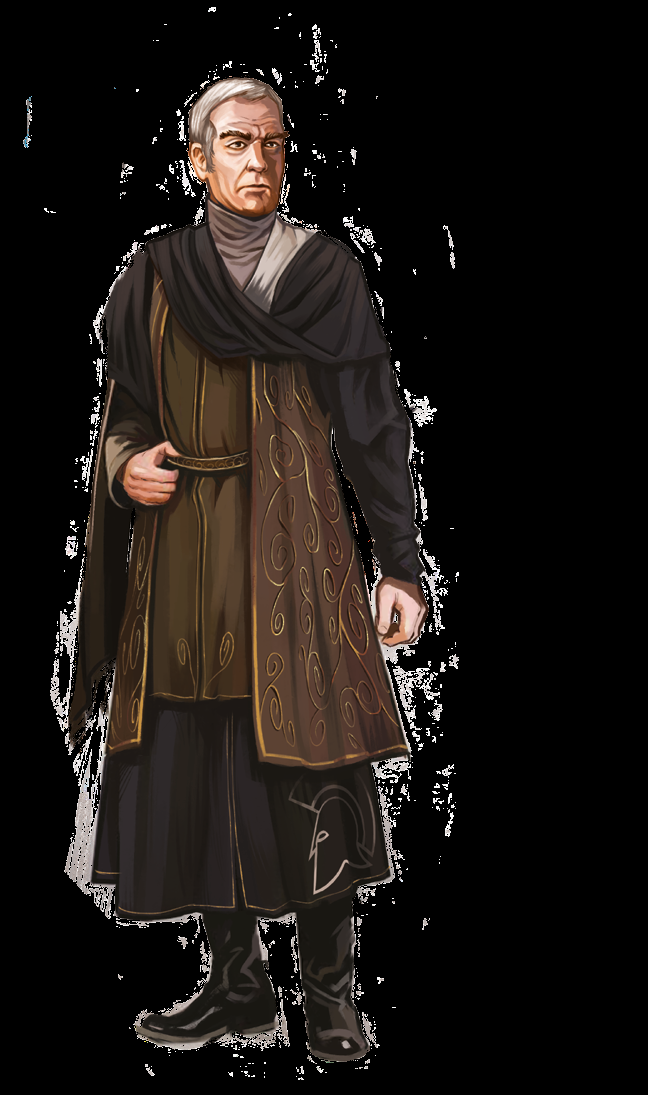
Pietrich Van Dyn, may or may not include mind control parasite
Stations
Galia
Population: 500.00
Depth: -400 to -1.700m
Fertile population: 19%
Mutant population: 19%
Galia in an industrial city that is primarily occupied by managing the automated surface factories. Wait no, it's actually a research hub that sends out pirates to bring back relics from the surrounding sunken cities. Sorry, I got that wrong, it's a mining city that mines up Cylast and tri-terranium from a depth of 2850 meters. Make up your fucking mind already Tessier. Err, hang on, I believe it's a fortress city in the war against the Burrowers now.
Ka
Population: 60.000
Depth: -200 to -250m
Fertile population: 37%
Mutant population: 23%
The Union's breadbasket and major agricultural research hub, branching out into a few surface factories and research outposts. It is a pleasant place to live, with houses on average having 20m² space per inhabitants, over five times the world's average. So much for Union cities being more cramped than everybody else's.
Neo-Troy
Population: 100.000
Depth: -490m
Fertile population: 27%
Mutant population: 12%
Here be the government. Located nowhere near Troy.
Omeross
Population: 50.000
Depth: -1.700m
Fertile population: 12%
Mutant population: 23%
A fortress city and the westernmost border of the Union. Most trade flows through here and it's detection systems are so advanced that it is impossible to sneak through the strait of Gibraltar without being noticed.
Syrte
Population: 60.000
Depth: -3.900 to 4.200m
Fertile population: 17%
Mutant population: 23%
Home to the Church of the Prophet, which got started following archeological discoveries among the neighbouring ruins. Some say the Prophet is a Genetician, others that he's a spiritual guide incarnated to lead humanity back to the surface. They have their own language called Nezraisian, also taken from the surrounding ruins and most members are scientists or scholars. Aside from the CotP, the Fellows of the Deep(fantasy daesh) are also rumoured to be present here. Lastly, like Neo-Troy it's several hundred kilometers off from it's namesake, being located more closely to Benghazi than Sirte.
Tamez
Population: 60.000
Depth: -2.990 to 3.200m
Fertile population: 16%
Mutant population: 14%
An industrial city dedicated to processing raw materials. It's position also makes it a "frontier" town towards the Rift States whatever that means because the Mediterranean Union and the Rift States are supposed to be allies now.
Next time: Minor nations
Book 1, Chapter 1: The World of the Deep, section 1.2: Civilizations of the Deep
Original SA post
Polaris RPG(2016)
Part 13, Book 1, Chapter 1: The World of the Deep, section 1.2: Civilizations of the Deep
Minor Nations
The great nations only form a small section of humanity under the ocean, the majority lives in independent stations(I highly doubt it because the Coral Republic, Hegemony and Red League add up to 200 million by themselves and 450 million was given as the world population at the start of the fall of the Azure Alliance and that was just at the start of the sterility crisis and ahead of the third set of apocalyptic world wars), where they slave away in the mines and hydroculture fields or fight against the never-ending attacks from pirates, sea monsters and other dangers. Despite their subsistence living, the independent stations completely eclipse the five major nations combined in military and industrial might if put together, somehow and all of them are wholly dependent on imported resources and foreign manpower, you know, completely the opposite of what the last 28 pages have been telling us at length. Equinox is a major hub of these kinds on contracts getting signed and according to the book the independent stations will be even more influential in the future because today's superpowers are waning(actually only the Red League is dying, everybody else is doing fine). Some of them have even begun forming into new nations themselves, of which the book presents "a few"(read: all of them because the map is full):
Amazonia
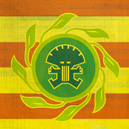
Clearly these smaller and slightly less overdesigned flags are what will lead these newcomers to triumph as the powers that be collapse under an uprising of enraged vexillologists.
Amazonia is a closed off state that only a handful of outsiders are allowed to visit. It's ruled by a king called Basanf who occasionally meets with representatives from the Cult of the Trident but otherwise nothing is known about Amazonia other than that they have a well developed pharmaceutical industry. Haha just joking here's their detailed capital writeup.
Amazonia
Population: 36.000
Depth: -140m
Fertile population: 48%
Mutant population: 20%
Nobody knew Amazonia existed up until 8 years ago until Lavara Teknacos, it's diplomat to Equinox, rolled up. Barely any outsiders are allowed into the city and others are reliant on long range surveillance to see that the station is unusually close to the surface(not really, see Coral Republic) and that the locals are mining some unknown, diamond-like material. The city is protected by a large energy field of unknown source and priests of the Trident are not welcome, leading to rumours that the city is under control of the Black Sun(again, contradicting the previous paragraph). Amazonia also harvests from hundreds of ancient ruins, from which they take both their language, Amanean, and their religion, the worship of a snake bodied god named Leziryss(note: Amazonia is located in Bolivia, which is nowhere near any civilization that worshipped Kukulkan or Quetzalcoatl). Amazonians also have an unexplained ability to speak Arkonian(The book will not explain why that is important for another 30 pages. It's the Genetician language). Ecology wise, the region is plagued by predatory fauna but Amazonia's pharmaceutical industry is capable of producing many high quality plant based medicines which are in high demand all across the world(All of it is Azurean. The book will not tell you this where it makes sense to say that, namely here, but in the equipment chapter, some 300 pages further in).
The Enderby Confederation
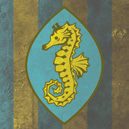
Some crude google maps distance estimating shows the nearest seahorse population to be 7000km away from where Enderby is. Good job.
The Enderby Confederation is a mining community led by a woman named Emma Peterson and constant rival to nearby New Lemuria, fighting over local mineral resources. Recently, Equinox oversaw the signing of a treaty so maybe they'll become friends in the future.
Cape City
Population: 30.000
Depth: -2.100m
Fertile population: 14%
Mutant population: 17%
Cape City is the only permanent human habitation in Enderby, the rest is all mineshafts. With the new diplomatic ties between them and their old rival New Lemuria, the states may soon merge into a single larger one. Explorers sent onto land have discovered traces of a Genetician depot.
The Rift States

This would be a functional flag if they had just stuck to the pyramid, Ahnk symbol and sun disk so they just had to go and put hundreds of polka dots on the background.
The Rift States are located in the fertile Red Sea and are the world's premier foodstuffs producer. Somehow. Despite having only 28.000 people compared to the Coral Republic's 127 million. Keep that first number in mind, it will become important soon. They are friends with their neighbours and ruled by a productivity commission.
Ossyr
Population: 22.000
Depth: -300m
Fertile population: 37%
Mutant population: 1%
Ossyr is one of the largest commercial hubs in the world(Coral Republic and Red League say hi) and stretches down several kilometers into the depths(I'm sure it does given that it's located somewhere around the Dahlak Archipelago where wikipedia tells me the maximum depth is <200 meters. This also directly contradicts the stat block above). In addition to being a trade port, the "city of a thousand wonders" is also a major tourist destination and the temple to the sun god Ossyr is one of the greatest sights in the underwater world. They also decided to name their local language, Ossyrian after it.
Ziar
Population: 14.000
Depth: -665m
Fertile population: 13%
Mutant population: 19%
A city of 22.000 inhabitants and one of 14.000 somehow add together to form a country of only 28.000 people. A+ rating would let Tessier do my math homework again. Ziar is Literally Dubai and consists of an upper class of traders and merchants living in opulence and many imported labourers exploited in squalid conditions. The book has completely forgotten about the Ziar Empire in the Mediterranean Union history section.
The Cape Federation
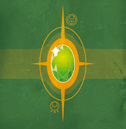
Somebody misunderstood the idea of smaller flags and instead shrunk down a big one to the point where it's not even possible any more to see all the little details.
The Cape Federation is a collective of 34 diamond and gold mining settlements(consisting of 24 regular stations and 12 major cities... I think Tessier may be suffering from discalculia) led by Supervisor Elliot Deminsk. It has a population of 189.000, many of which used to be mercenaries, hence it's relatively large fleets. Working conditions in the mines are terrible and the cities are constant under attack by Burrowers. It also has an arms factory and some rudimentary farming areas, where they co-operate with a large group of dolphins. HEY GUY'S ITS LITERALLY SOUTH AFRICA.
Draken
Population: 24.600
Depth: -410m
Fertile population: 12%
Mutant population: 13%
Draken operates many mines on the surface and thus has a bigger than average collection of backhoes.
Pitcap
Population: 52.300
Depth: -230m
Fertile population: 23%
Mutant population: 12%
Pitcap is the Federation's capital and largest mining city. The Burrower attacks are so bad that the Supervisor has recently purchased a lot of Hegemony equipment to counter their threat.
Walvis
Population: 40.200
Depth: -1.500m
Fertile population: 17%
Mutant population: 34%
Hey look at just how South African this place is! It even has random Dutch words for town names! It's under attack by Burrowers and pirates. Contrary to it's name translating to "Whale" it has nothing to do with cetaceans of any kind.
Fuego Liberdad
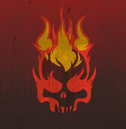
Flag design courtesy of Tessier's 14 year old nephew, I think.
The richest state in the region(despite being wedged between the Hegemony and the Red League), this community of 34.000 souls is owned remotely by a council of shareholders located in Equinox and is almost entirely focussed on mining Cylast and tri-terranium. It also features a very high birthrate and gets not one but two named characters, Admiral Pellock in charge of it's defence fleets and Cyrus Terling, it's majority shareholder in Equinox. On June 23, 567 Fuego was attacked by pirates and forced to call for foreign aid. The Hegemony answered but they didn't stop with driving away the pirates, instead they occupied the entire community and raided their newly discovered Genetician depot. This led to loud complaints but no further action by the S.M.S.O. Hang on, according to the Hegemony history section, the war started with an unprovoked Hegemonic attack and THEN the pirates got involved, leading to an embarrassing defeat and hasty retreat. Consistency!
Fuego Liberdad
Population: 34.600
Depth: -4.800m
Fertile population: 43%
Mutant population: 18%
Wow they truly do have the highest birthrate! 600 new babies born between their description paragraph and the statblocks! The mines are not running at full capacity and are expected to be expanded soon. There are rumours that the community secretly supports the pirate Telkran Raljik. By "rumours" the book means this was already confirmed 30 pages back.
New Lemuria

I can't tell if this is supposed to say something in a language I can't read or if it's just gibberish.
A 28.000 strong tri-terranium mining community led by Karl Onstarberg. It owns "a small fleet of cruisers" somehow.
Kergeulen
Population: 8.000
Depth: -1.600m
Fertile population: 10%
Mutant population: 26%
A drab and grey mining settlement. It's recently been surrounded by whirlpools and nobody knows why or how long they'll last.
Lemuria
Population: 18.000
Depth: -410m
Fertile population: 28%
Mutant population: 19%
Capital of New Lemuria and seat of it's ruling council. The state actively fights pirates and supports smaller independent settlements against them as well. The rivalry with the Enderby Confederation is never mentioned again.
Rhodia
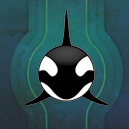
I'm the four different gradients of blue ruining up this otherwise sensible flag.
Rhodia started when the community of Rhode found an Azure Alliance depot. The new state is growing economically and attracts many migrants. It's previous council president, Paul Gan, died in an unspecified accident and has since been replaced by somebody named Victorius who aims to turn Rhode into the greatest economic nexus in the world, using machines found in the depot. This is the last time the entire nation is mentioned for the rest of the book. The rest of the ruling council is filled with priests of the Trident and the state does not have it's own military, relying solely on the Watchers for protection.
Rhode
Population: 12.900
Depth: -1.560m
Fertile population: 12%
Mutant population: 13%
Rhode is constantly under attack by pirates seeking to loot it's Azurean technology. The Cult of the Trident jealously protects said technology with it's Watcher fleets(remember, the Watchers are supposed to be independent from the Cult).
The Kingdom of the Indus

And we close off this post with another dose of single pixel details.
A wealthy and economically growing community of "over 45.000" inhabitants making a living from farming as well as mining copper, gold and Cylast. It's ruled by a Hegemonic nobleman who calls himself Duke Pillar de Rochas(Kingdoms are not ruled by dukes. It's right there in the name) who build a feudal society around himself.
Kryss
Population: 20.000
Depth: -215m
Fertile population: 29%
Mutant population: 6%
A typical KotI city where nobles rule over serfs with no rights at all but apparently the nobility provides them with decent living conditions. Awww, look at who's being all benevolent dictator here. The local language is Trashanes, a mix of old Azuran, Arkonian and an unmentioned language of ancient times. Kryss is also the drug capital of the world, exporting all kinds of hallucinogenic to every corner of the ocean.
Pushkar
Population: 32.000
Depth: -230m
Fertile population: 29%
Mutant population: 10%
Capital of the
The section ends with another Trident cultists letter to Equinox, this time from a spy in the KotI talking shit about the Duke and how he's an asshole for killing his political opponents by exiling them to the surface and that he may secretly have ties with the Ashniri as if that wasn't already blindingly obvious.
Next time: The Fellowship of the Watchers and some other unimportant losers who got lumped into a section with them.
Book 1, Chapter 1: The World of the Deep, section 1.2: Civilizations of the Deep
Original SA post
Polaris RPG(2016)
Part 14, Book 1, Chapter 1: The World of the Deep, section 1.2: Civilizations of the Deep
Are you all ready to dive into some weird layout issues? Let's dive into the next sub-sub-chapter of...
Important Factions and Groups
Here be everybody who doesn't have their own cities. Except when they do and the cities are lumped in with the independent ones a few pages yonder. Consistency!
The Azurean Alliance

Illegible garbage in the background of your flag seems to pre-date the third apocalypse.
The Azureans always believed that the Geneticians and their Empire of Evil could return so they left behind hidden bunkers full of combat robots and great warriors in hibernation or stasis. Wait, living Azureans? Dead end metaplot reference count: 16. Nothing else is known about them so I guess the largest faction in the setting being their direct successor state isn't actually true?
The Fellowship of the Watchers
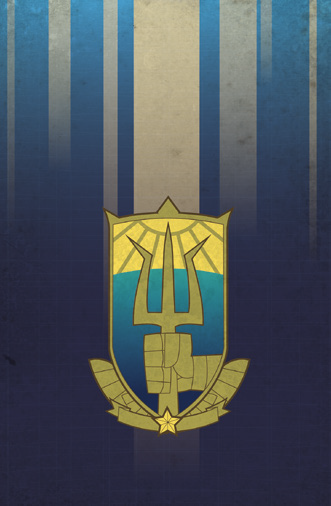
The hand grabbing the trident represents Tessier ripping off the Ukranian coat of arms wholesale.
From here on out, there are no more line breaks until the end of the Watcher writeup. They're all mine, added for legibility.
The Watchers are an international peacekeeping force working with the Cult of the Trident to make sure the orders from the S.M.S.O are followed. The book flipflops one final time on the Watchers' independence, finally settling on them being the Cult's army in all but name. In 566 this global elite army founded an even more elite mini-army that performs all the same basic tasks, those being protections of Equinox and a few other Cult points of interest, S.M.S.O policing duties and smacking down pirates.
The Watchers recruits both from volunteer sign ups as well as tithed soldiers from the S.M.S.O member state's armed forces. Every new recruit is carefully analysed for both physical prowess as well as ideological purity, with only the best candidates who are on board with the Cult being a pseudo world government being allowed to join, followed by a year of brutal training to weed out spies faking their conviction. This results in an army of uniquely high morale and comradeship where treason and espionage are rare, though some in Equinox say that the Watchers are straight up mind controlled by the priests of the Trident. Each Watcher sings on for 5 years, renewable at the end of each period, though the book is unclear how this works for tithed conscripts. Either way, the Watchers number approximately 300.000 soldiers in total, which makes it the 7th most populous nation under the sea all by itself, between the Mediterranean Union and the Cape Federation.
Next are the subdivisions which are somewhat of a mess in terms of layout and dropped with no introduction.
The security forces: A group of 14.000 Watchers who patrol the halls of Equinox. They are polite, friendly and helpful but are there to protect the city, not it's citizen so they are only stationed around important hangers, generators and that kind of stuff. The default armament is the Mao truncheon(which is actually an object in the armoury section for once!) and when serious threats manifest, they will suddenly magic thermal lances(think power weapons from WH40K) and assault rifles out of thin air. The next sentence...
this book posted:
Their leader is Colonel Palance, a 56-year-old man close to Lopteros
(find more information about Ariadne and Lopteros in the
Equinox sourcebook).
 It's splatbook shilling time!
It's splatbook shilling time!Maybe I won't be too mean about this one because unlike the other ones the book tries to sell you, this one actually exists. I don't have it though so unless somebody else is willing to dig it up we'll just have to go with what the corebook says about Lopteros: He's the Hard Choices™ dude who is blatantly a WH40K Inquisitor ripoff.
Anti-riot forces: The biggest danger to Equinox are stampedes which is what these guys are to contain. Actual riots are, somewhat non-intuitively, handled by Condor Faction instead. Mass panics are typically caused by fire, flooding, sudden firearm use or sick looking people(the book says Equinoxians are all germophobes but I think it has more to do with their counterfeit inquisitor boss burning down an entire quadrant again if he gets word of it). When this happens, the stampede is contained by means of airlocks slamming shut around it and soldiers with intimidating looking armour, truncheons and electrified shields appear and pacify the crowds with sonic and electric weaponry. Once the unruly population has been dealt with, it's time to investigate the source of the disturbance and tend to any wounded(going by the book's combat rules, most of these would be citizens they themselves have shocked into a coma or cardiac arrest). When this is not enough, Condor Faction joins in as well. Condor Faction is led by Major Fianna Liparsky, a 46 year old woman why is rumoured to be fertile(whyyy).
Condor Faction: Wait, didn't these guys get discussed in the last paragraph, down to the inner working of their commander's uterus? Yes, they did. Formatting! Between that paragraph and now their list of tasks has undergone some mission creep and now they are responsible for not only mass panics and riots but also terrorism, epidemics and "various catastrophes", which I'd imagine covers the general breakdown of society caused by Anti-riot forces zapping too many works into vegetables. Their armour is black and their logo is that of a flaming bird(Phoenix. Tessier, the word you're looking for is Phoenix. Not Condor), which due to their fearsome reputation will calm most rioters. When that fails,
The hygiene services: Actually titled Hygiene and Epidemic Control Services. Tessier, you know you can like, delete the old name before this goes to the printers instead of writing a correction after it, right? More feared than even the murdercops or the other, bigger murdercops, the HECS provide free healthcare to the few brave enough to approach their office because many who walk into there never return. They work on the ancient Greek system of healthcare though, where they will straight up murder anybody who is actually sick instead of helping them. They have their own propaganda wing and children are taught to be watchful for any signs of the infected at every level of education. Not content with having just the population be their spies, they also patrol the streets of Equinox themselves looking for any hints of infectious germs. When they do, they deploy their own soldiers to take out the potential plague carrier. When that is not enough, they too have a set of XXL murdercops, titled the Incinerators who are more feared than the other three kinds of death squads. They are lead by a 32 year old sterile woman named Doctor Lena Temis.
The emergency services: The fire trucks and ambulances department. Strangely enough for a Watcher sub group they do not possess any Einsatzgruppen with which to hunt down NFPA code violators, which leads them to being the most popular Watcher division in Equinox. Led by Lieutenant Peter Davis, who is 38 years of age and sterile.
The army: An 180.000 strong group of elite soldiers who protect Equinox and the space bases, as well as serving as marines aboard Watcher ships. The book tries to explain their rank structure starting with soldiers(who are primarily within the 24 to 34 age bracket because demographics are important yo) but immediately segues into how the army is subdivided, namely:
-Scion Division(ship crews)
-Fighters(underwater plane pilots)
-Marine Commandos(power armour wearers)
-Dawn Division(underground and surface troops)
-Intervention Division(an elite force within an elite force within an elite for who are good at close combat inside stations. The 5th Watcher death squad in Equinox by my count)
-Cyclops Division(static fortification crews)
-Space Division(guards launch sites and serve as peacekeepers aboard space stations)
After that sidetrack come the rest of the ranks, those being:
-Major(20 soldiers, 10 commandos or 5 fighters) This is clearly supposed to be a Sergeant and I don't know what went wrong because the French term for that is Sergent so it's not a simple mistranslation. Or maybe
-Lieutenant(combat groups of up to 200 soldiers)
-Captain(as in ship captain)
-Colonel(5-20 combat groups) 20*200 is 4.000 so the security forces up there are overstaffed by 10.000 soldiers by these numbers. Tessiermath best math.
-Squadron Admiral(a squadron of ships)
-Admiral(in charge of one a geographic area and all ships therein. There are six fleets and thus six admirals) Utter nonsense as we'll find out next post.
-Admiral in Chief(a dude named Len Veria who talks to Demeter apparently)
Next comes the Special Intervention Group, or the S.I.G. for short which is an elite specialist division(no we're still not done with those) They come in the following flavours:
-Hybrids, which are deep water saboteurs, containing both geno hybrids created by the Cult as well as natural ones. They are led by Lieutenant Jessica Xe, an 28 year old natural hybrid.
-The Sword(Or S.W.O.R.D.(or Special Warfare Operations and Recon Department)) are an especially badly edited unit of deep water saboteurs led by a 56 year old former pirate who listens to the name of Ulorf Grender.
-Astra Division, more space police. There are less than 50.000 space colonists, I'm sure they can get by with just one military police force.
-Shadow Division. No silly acronym this time, just more spies and infiltrators.
The Watchers also have their own research laboratories, mostly focussed on weapons tech because of course they do.
Next time: More Watcher shit.
Book 1, Chapter 1: The World of the Deep, section 1.2: Civilizations of the Deep
Original SA post
Polaris RPG(2016)
Part 15, Book 1, Chapter 1: The World of the Deep, section 1.2: Civilizations of the Deep
Welcome back to the second part of the Fellowship of the Watchers table of organization and equipment.
Next up are the "Civilian" Watcher ships, made by the company Gladius. Tessier has no idea what the word Civilian means.
8x Archangel-class hospital ship, 35.000 metric tons, 125 meters length. Holds 500 patients.
10x Dolphin-class rescue ships, 60 meters long and a maximum dive depth of 18.000 meters which is nice if somebody gets stranded after digging down 7 kilometers into the seabed of Challenger Deep.
2x Behemoth-class salvage ships, 120.000 tons of "hollow half pipes". I've never seen a pipe that isn't hollow, hollowness seems to be integral to an object being a pipe as opposed to a stick.
30x Korems-class sea floor APC's. "Civilian". Also this is about one battlefield taxi per 6.000 soldiers, better make it count!
Finally, the Watcher's actual combat fleets. There are six fleets, four of which follow the same basic pattern:
1st squadron(interception): 5x escorts, 20x heavy fighters
2nd squadron(surveillance): 2x escorts, 40x light fighters, 1x frigate
3rd squadron(rapid intervention): 2x frigates, 1x cruiser
4th squadron(protection, stationed at equinox): 4x frigates, 1x cruiser, 1x battleship
5th squadron(intervention): 6x frigates, 2x cruisers, 1x battleships
6th squadron(flagship squadron): 20x escorts, 8x frigates, 4x cruisers, 1x battleship
The 5th fleet are the underwater police, owning about 40 escorts and frigates.
The 6th fleet are merchant escorts and also have 40 ships like the 5th but own a few cruisers as well.
The overall flagship is custom built and named Vigilant. A second one titled Valliant(sic) has been recently launched as well.
Remember that bit about each admiral commanding a big chunk of territory with the implication that they'd be in charge of one of the six fleets because of that. Umm yeah about that...
Admiral #1 will control his own fleet as well as a battleship each from #2, #3 and #4 and 1/6th each of fleets #5 and #6
Admirals #2, #3 and #4 on the other hand are missing their battleships but still have the escorts from #5 and #6
Admirals #5 and #6 get no battle fleets whatsoever and only control 1/6th each of their own and the other's fleets.
Comedy bonus: Because the last two fleets are mobile, who owns what ship will change every few days. Happy admiral-ing!
The Geneticians

This logo can't be copied for some reason so I just had to screencap Adobe for this. It seems barely perceptible background crap was a thing even before the second apocalypse.
Whoa this sub-sub-chapter actually was about more than just the Watcher's 40k wankery? I almost forgot because of just how lopsided the coverage was. These guys formed the first global empire despite there being just 24 of them, 12 creators, 6 destroyers, the latter of which are in stasis in various buried depots(Dead end metaplot reference count: 17) and depots and 6 renegades(which might include Demeter depending on who you ask. The answer is definitely no because we as omniscient observer were told his exact age of 113 which is about 450 years too young). The book only bothers naming about a third of them:
Cyrull the Creator, Nellion the Designer, Masenya the Founder and Vagarem the Thinker are creators.
Arisheïm the Destroyer, Galeshor the Executor, and Nisheim the Redeemer are destroyers.
You can now forget about those names because aside from Cyrull, which is Tessier's online handle, none will ever show up again anywhere else. The Geneticians are rumoured to be awaiting the "Renaissance", during which they'll return or something(18).
The Black Sun Fellowship
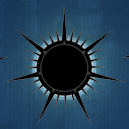
The Black Sun Fellowship are quite simply, Death Eaters from Harry Potter who wish to replace the Cult of the Trident and it's more guiding role(hahaha) with a dictatorship where an upper class wizards rule over muggle "animals". They have spies and sleeper agents everywhere all waiting for the day when they'll seize power and when they do get in open conflict they are known for their highly manoeuvrable fighter craft(spoiler from the equipment chapter: they aren't). Despite being wizard supremacists, only a tiny fraction of them actually has enough control over the Polaris Flux to do anything with it. They are led by a powerful spellcaster known as the Other and their spokesperson, Alemsh Palkrach, is a defector from Jason Helio's inner circle. Many think that the only thing separating the Cult of the Trident from the BSF is better PR.
The Fellowship of the Deep
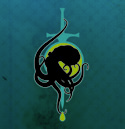
Literally fantasy ISIS. A murderous death cult who believe that the (4th) apocalypse will happen in their lifetime and only a chosen few will survive and only if they spend their time putting infidels to the sword. Former Ruins Raider pirate Ralaken Trillsak founded the cult after discovering an ancient engraving depicting the apocalypse somewhere in the Mediterranean and now his ten "archangels" recruit desperate recruits from the various slums of the world, spurring them to commit atrocities. If they survive, they travel to Trillsak's hideout somewhere among the ruins of the Mediterranean coastline before returning to act as sleeper agents and cause chaos and bloodshed when the time is right. They have tacit support from many wealthy individuals who think they can use them as a tool against their enemies and as a result most intelligence services are rather lax with operations against the FotD though if an individual is found with the cult's mark, a tattoo of a black dagger, they are typically executed on the spot. There are rumours that Trillsak is not fully human any more as a result of his discovery.
The Leviathan Community
No flag for these guys! Or anybody else. The book is now out of flags.
A community of reclusive whale tamers who live in the Aleutian trench which Tessier claims to have a maximum depth of 18.000 meters. Outsiders are forbidden in their territory and only rarely does an emissary travel from their home to Equinox to speak with Demeter, always clad in a heavy leather coat and a face concealing mask(like everybody else). Nothing is known about them other than that their whale friends completely trashed a Polar Alliance fleet of 6 frigates, 2 cruisers and a battleship that violated their territorial waters(note from the bestiary: they can't actually harm any of these ships).
Themis
A group of rich Hegemony folk who politically oppose the brutal treatment of fertile Hegemonians. They also sponsor the assassinations of slave trading pirates. These sound like cool dudes to put in the Hegemony sub-sub-chapter.
Thelma Tiltane and the Hegemonic Rebellion Movement
Here's some people who actually were in the Hegemony section but they're repeated here with less detail anyway. Unlike Themis, TTatHRM is a lower class movement except they have their own supporters among the nobility who are apparently not with Themis?
Mercenaries
Not actually part of the important(hah) groups and factions sub-sub-chapter by the book's index and page layout but are written as if they were so I'm including them here(also because next post would be very short if I separated them)
One in three independent communities are mercenaries(make that one in twenty if we're going with what the next section says), with the smaller ones focussed exclusively on it while larger ones might diversify into producing other goods as well. A mercenary's equipment is typically a
patchwork of second hand materials barely kept running by enterprising tinkerers. The book lists a few groups:
Legion: The largest group of mercenaries "ever", with a larger army and fleet than the average nation state. Their capital of Cerbera/Cerberea(depending on where in the book you look) is also the world main hub for other independent mercenaries to find contracts, some 12.800 in total(Legion included). They currently have contracts with the Hegemony, Red League and Coral Republic, mainly fighting pirates. Their leader is a 59 year old former League admiral named "One-Eye" Valerius.
The Kiowas: A newcomer group who quickly established a reputation as fine and well behaved pilots fighting against pirates in the defence of Adelaide. They mainly fight with Mantas, Sleepers and sea scooters.
The Gabriel Cohort: A group of 800 underwater commandos specializing boarding and sabotage. Employs various kinds of hybrids and is based in the Amirante Trench.
The Mad Dogs: Another new group based in the Java Trench. They have a fearsome reputation but are typically somewhat unhinged, living only to fight and scream profanities into their communicators while doing so. Their leader is the 34 year old "Psycho" who can barely function outside battle.
The Wolves of the Deep: Former Ruins Raider pirates led by the nearly two meter tall athlete Morgan Felshner and based on the Vøring Plateau(here incorrectly rendered as Voring instead of Voering). Specializes in fighting underground and on the surface.
Pirates
Pirates are found everywhere but most make their home in the mountainous regions of the pacific where it's easier to shake off pursuers in the constant maelstrom of whirlpools and currents. Like with mercenaries, the book tells us of the most famous ones:
The Ruins Raiders: Not actually a singular pirate group(good start) but a collective term for any scavenger making a living from combing through sunken surface ruins. Life so close to the surface is often dangerous and short, with horrible living conditions and old and barely maintained equipment(somebody should tell the Coral Republic).
Telkran Raljik, Pirate of the Deep: Look at this tryhard here, getting both a title and an entire entry by himself. Jokes on him though, this entry is actually about his ship, the Argonaut. It's an ultra modern heavy cruiser that many intelligence services would like to get their hands on but so far it's complement of 26 fighters, 120 power armoured commandos and schools of tame dolphin infantry has fought off every attempt to capture it. What it can't defeat, it can evade with it's exceptional maximum diving depth and many hidden supply stations. Telkran mainly busies himself skirmishing with the great nations.
The Unicorn Fellowship: A newly founded group, known for the pillaging of Kathai(no such place in the book) together with Erik Left-hand and Six-toothed Andrack in 561. Their leader, Killrave, personally hates human traffickers and attacks them every chance he gets but the group suffers from being based out of badly worn out stations in constant need of repair.
The Red Lions of the Carolinas: A nomadic group of barbarians travelling aboard a fleet of large Genetician cruisers. Their leader, Aragon "Emperor William" Pimoud leads them around the oceans, plundering everything that they encounter. You'd think a marauding fleet unstoppable lostech ships would've come up before.
The Tubuai Assailants: A fanatical cult worshipping a mutant leader who styles himself after an ancient deity, who's statue he found among the ruins of the surface.
The Predators: Operates a fleet of 300 or more cruisers all around the world and is more interested in fighting than accumulating wealth. Often spares worthy adversaries. Their leader has the title of Shaitan, which is granted to whoever bests the previous one in single combat.
The Dagger Fellowship: A new pirate community led by the youngest pirate captain ever, Len, who commanded his first ship at age 15 and is now 25. United the Pirate Kingdoms in their war against the Coral Republic(This war happened 200 years ago so he might be a time traveller. Or Tessier is shit at consistency).
Seyar the Damned: The most wanted man of the seas due many intelligence communities suspecting him to have the answer to the sterility crisis. Claims to be on a secret mission and hates Len from the previous entry. Funds many researches into the Azure Alliance with his ill-gotten fortunes.
Smugglers and Bounty Hunters
Listed as a separate header under pirates. Actually includes scavengers as well. Smugglers are generally individualistic and don't form groups. Bounty hunters do the same with one notable exception, the Equinox based Bloodhound company who's activities are legal in all states.
Scavengers scour wrecks for useful salvage. Some groups have an uncanny ability to tell where and when a major clash will take place and often show up ahead of times to strip vessels as they sink while the battle rages on above them. Generally considered excellent technicians.
Next time: That 12 pages long list of settlements.
Book 1, Chapter 1: The World of the Deep, section 1.2: Civilizations of the Deep
Original SA post
Polaris RPG(2016)
Part 16, Book 1, Chapter 1: The World of the Deep, section 1.2: Civilizations of the Deep
Welcome to the final part of chapter 1, section 1.2. It's the 12 pages wall o' text about the 80 independent settlements. Despite it's humongous size it's even dryer than the rest of the fluff and there's barely even anything for me to snark at for being bad and/or contradicting itself. The lowlight of this section is Georgia and the only other minor note of interest is Achilla if you'd rather skip ahead.
The stat block has now been expanded to also include leadership forms which I've also copied, mostly just to show off the occasional disconnect between what it says who's in charge and who the text says is. The station type entry is left out as usual due to it saying the exact same thing for 78/80 entries.
Achilla
Population: 12.000
Depth: -3100m
Fertile population: 17%
Mutant population: 23%
Government/ruler: dictatorship Zemo
Zemo's a paranoid asshole who thinks everybody's a spy from New Lemuria or the Coral Republic trying to overthrow him. His constant mass arrests left the armed forces so understaffed that half the fleet is unable to leave ports. Looks like Tessier ended up a few descriptions short right before the printing deadline and ripped off the headlines about the 2016 Turkish coup attempt and subsequent purges. If not, this is oddly prophetic. He's also the heir to the founder of the megacorp Raecor Enterprises, one of the wealthiest individuals in the oceans.
Adelaide
Population: 2.300
Depth: -810m
Fertile population: 11%
Mutant population: 6%
Government/ruler: council/Larkater
Gets raided by pirates a lot so they hired the Kiowa mercenary group. Hopes to start mining operations on the Bellingshausen Abyssal Plain in the future.
Angel
Population: 1.800
Depth: -200m
Fertile population: 13%
Mutant population: 23%
Government/ruler: council/Helena
Mining and factory town selling to the Hegemony and Red League. Naturally, burrowers.
Astrid
Population: 868
Depth: -593m
Fertile population: 13%
Mutant population: 6%
Government/ruler: council/Merolar
Extremely remote mining station with terrible living conditions and resupply so infrequent that most inhabitants have not left it for 10 years or more. In a cold war with Pelial over a tri-terranium vein.
Cerberea
Population: 28.000
Depth: -1.100m
Fertile population: 16%
Mutant population: 11%
Government/ruler: none/"One-Eye"
Mercenary hub for the Legion and a whole lot of independent ones. Attacked by pirates once, didn't go over so well.
Cheko
Population: 1,400
Depth: -255m
Fertile population: 11%
Mutant population: 4%
Government/ruler: board of director(sic)/Ryan Terd
Owned wholly by the corporation Vigilant, reportedly deploying an experimental surface station to get one up over it's rival, Tsoi.
Clintok
Population: 900
Depth: -200m
Fertile population: 12%
Mutant population: 10%
Government/ruler: council/Rellan Deric
Generic farming town.
Coiba
Population: 2.600
Depth: -350m
Fertile population: 12%
Mutant population: 4%
Government/ruler: administrative council/Leo Paral
Hegemonian owned under the guise of the corporation Neotech, buffer towards the Red League. Has outlived it's usefulness and will soon be annexed.
Crescia
Population: 200
Depth: -10.261 and 19,500m
Fertile population: 10%
Mutant population: 40%
Government/ruler: council/Elma Derling
Joint op archaeology outpost by the Watchers and Coral Republic. The Watchers have stationed no less then three kinds of commandos here because that's what they do.
Cross
Population: 1.145
Depth: -200 to 435m
Fertile population: 19%
Mutant population: 23%
Government/ruler: religious council/Milus the Visionary
Built into the wreck of a Cult of the Trident monastery ship by Milus Trend to practice future-christianity in. Still friendly with the Cult and trains their priests in combat. Considers Hell and Litua to be infested by demons and wages a permanent crusade against them, with Demeter's tacit support because of suspicions that they're full of Black Sun.
Crozet
Population: 1.400
Depth: -410m
Fertile population: 11%
Mutant population: 17%
Government/ruler: council/Leia Lamark
Runs some Cylast mines at 4.600m depth. Allied to Oster.
Cunha
Population: 2.600
Depth: -900m
Fertile population: 11%
Mutant population: 14%
Government/ruler: council/Yvan Pelis
Gets pirated at a lot. Might be full of Black Sun.
Dem
Population: 850
Depth: -760m
Fertile population: 10%
Mutant population: 43%
Government/ruler: council/Griswald
Led by a mutant who never shows his face(I'd think it would be more notable if this was NOT the case). Similar to Frao.
Djour
Population: 2.100
Depth: -215m
Fertile population: 11%
Mutant population: 19%
Government/ruler: council/Laer Trenp
Trades exclusively with Cheko because dangerous currents separate it from it's other neighbour Laipur.
Esio
Population: 1.200
Depth: -225m
Fertile population: 23%
Mutant population: 23%
Government/ruler: council/Ameiya
Has given up on spending money on defense and just gets pirated on a weekly basis after neighbouring Extur was wiped off the map.
Ferlo
Population: 17.000
Depth: -200m
Fertile population: 11%
Mutant population: 11%
Government/ruler: council/Klyss
A farming town that is supported by a swarm of 6.000 dolphin wizards.
Ferra
Population: 0
Depth: -903m
Fertile population: 0
Mutant population: 0
Government/ruler: none
Ferra's entire population of 900 mysteriously vanished a few months ago. Watchers are en route to investigate.
Frao
Population: 1.200
Depth: -215m
Fertile population: 15%
Mutant population: 23%
Government/ruler: council/Olaf Debeure
Mining and trader layover station. Formed a defensive pact with Dem and Olysia.
Gabriel Cohort
Population: 3.800
Depth: -6.000m
Fertile population: 11%
Mutant population: 1%
Government/ruler: military hierarchy/Ameross
Underground and suspiciously burrower-free base home to 800 high quality commandos and their families. May have access to several Genetician facilities.
Gateo
Population: 200
Depth: -4.100m
Fertile population: 0%
Mutant population: 0%
Government/ruler: fellowship/Kroll
A community of farming monks let by an ex-Trident priest living inside an completely impenetrable Genetician force field. No fuck you players, you can't break in.
Gaza
Population: 2.100
Depth: -460m
Fertile population: 12%
Mutant population: 11%
Government/ruler: council
Another entry in the "actually nowhere near the place it's named after" list. A mining town that recently discovered some kind of ancient ruin.
Georgia
Population: 4.500
Depth: -615m
Fertile population: 8%
Mutant population: 46%
Government/ruler: none
Oh dear, here we go again.
 ahead. Georgia is an unrecognised mercenary state aiding Varevris in their war against Orca. Their farming techniques are apparently so revolutionary that the Cult of the Trident wants to recognize them in exchange for it. Their leader, Kyl Graven has refused, being single-mindedly obsessed with acquiring Orca's fertile population and enslaving the rest. So far he has captured 30 fertile Orca inhabitants.Georgians also have some kind of telepathic link to tiger sharks or something.
ahead. Georgia is an unrecognised mercenary state aiding Varevris in their war against Orca. Their farming techniques are apparently so revolutionary that the Cult of the Trident wants to recognize them in exchange for it. Their leader, Kyl Graven has refused, being single-mindedly obsessed with acquiring Orca's fertile population and enslaving the rest. So far he has captured 30 fertile Orca inhabitants.Georgians also have some kind of telepathic link to tiger sharks or something.Helene
Population: 17.000
Depth: -3.200m
Fertile population: 23%
Mutant population: 17%
Government/ruler: empress Telenea
Involved in the "War of Three Cities" together with Luan and Tyr. Owes most of it's relevance to it's Genetician depot and the Liberius, an Apocalypse-class cruiser found within. Empress Telenea is well liked but her territorial claims annoy the Watchers, who are closely watching for any casus belli to invade.
Hell
Population: 18.000
Depth: -350m
Fertile population: 14%
Mutant population: 6%
Government/ruler: council/Gunter
Aggressive and expansionist... farming community? ...right. Doubled it's size the last few years and has branched out in raiding surface ruins, where it found it's new religion, Odinism. Aside from that, they also worship orcas and have befriended a few them which carry their best warriors around. No mention of the Black Sun infiltration that was referred to in the Cross entry.
Horn
Population: 4.700
Depth: -1.159m
Fertile population: 19%
Mutant population: 15%
Government/ruler: council/Leipver Tren
Former Red League city still maintaining close ties to it's former overlord, acting as fleet outpost for them. Operates mines at 3.800 meters and geothermal power plants at 3.000.
Kalima
Population: 2.200
Depth: -225m
Fertile population: 12%
Mutant population: 27%
Government/ruler: council/Kali
Home to Kali, the leader of the Tubuai Assailants that the book didn't see fit to actually name in the relevant section. Sort of a neutral meeting place for pirates, eyed suspiciously by the Coral Republic.
Katal
Population: 29.200
Depth: -200m
Fertile population: 23%
Mutant population: 24%
Government/ruler: council/Oloch Berua
Farming town that gets pirated at often enough to bother hiring Legion mercenaries. Sucks as pesticide use to the point that they also need the Legion to chase off local wildlife from their new planned farms.
Kell
Population: 1.800
Depth: -213m
Fertile population: 10%
Mutant population: 24%
Government/ruler: council/Larxin
Cylast mining settlement and waystation between the Hegemony and Polar Alliance.
Laipur
Population: 900
Depth: -535m
Fertile population: 23%
Mutant population: 17%
Government/ruler: Dran Kresh
Only town to have contact with the Leviathan community. Runs some mines for the whalemongers at 15.000 depth.
Lamarch
Population: 750
Depth: -252m
Fertile population: 11%
Mutant population: 23%
Government/ruler: council/Regnar Trav
Mining town operated by an ex-pirate.
Largan
Population: 2.976
Depth: -475m
Fertile population: 42%
Mutant population: 98%
Government/ruler: council/Palia
A nursing home for mutants run by research company Palia.
Leical
Population: 7.000
Depth: -350m
Fertile population: 20%
Mutant population: 15%
Government/ruler: administrative council
Hegemony funded mining settlement. Fights burrowers.
Leng
Population: unknown
Depth: unknown
Fertile population: unknown
Mutant population: unknown
Government/ruler: unknown
H.P. Lovecraft reference. Rumours and eyewitness accounts abound but no definitive evidence that it even exists.
Leyfa
Population: 1.960
Depth: -450m to -700m
Fertile population: 15%
Mutant population: 18%
Government/ruler: council/Pyrus
A farming town that recently got into mining Cylast. Supplies Cross with foodstuffs.
Litua
Population: 1.500
Depth: -435m
Fertile population: 38%
Mutant population: 48%
Government/ruler:council/Polyaden
The other Odinist town. No Black Sun either.
Llend
Population: 700
Depth: -600m to -7.800m
Fertile population: 10%
Mutant population: 10%
Government/ruler: none/Kali
Floating "pleasure station" owned by a mysterious individual who may or may not be Kali. The trench it's located in has a depth of 10.000 meters.
Luan
Population: 26.000
Depth: -230m/-5600m
Fertile population: 34%
Mutant population: 12%
Government/ruler: council
Another troublemaker from the War of Three Cities. Officially independent from it's founding company, Kilian Industries but secretly supported by them in the war.
Mad Dogs
Population: 120
Depth: -8.800m
Fertile population: 10%
Mutant population: 50%
Government/ruler: none/Psycho
A ramshackle collection of undersea huts barely kept dry by the families of it's namesake mercenary company. Every single person has his own personal religion and is "well learned" as a result of exploring many surface ruins.
Maio
Population: 26.00
Depth: -100 to -4.000m
Fertile population: 17%
Mutant population: 28%
Government/ruler: council/Cleo
An isolationist dictatorship operating diamond mines and worshipping the earth-god Cristal who supposedly lives at the bottom of their deepest mine.
Malia
Population: 0
Depth: -200m
Fertile population: N/A
Mutant population: N/A
Government/ruler: N/A
A mining town wiped out by Moloch 27, a disease from a Genetician depot. Under quarantine by the Watchers, who will destroy any ship trying to enter. Broadcasts strange radio transmissions.
Halfway point, time for an art.

Here's a city that's far too large to be any of these places.
Next time: Independent stations Manag - Zemble